Contents
- 1. User manual_Part 1
- 2. User manual_Part 2
User manual_Part 2
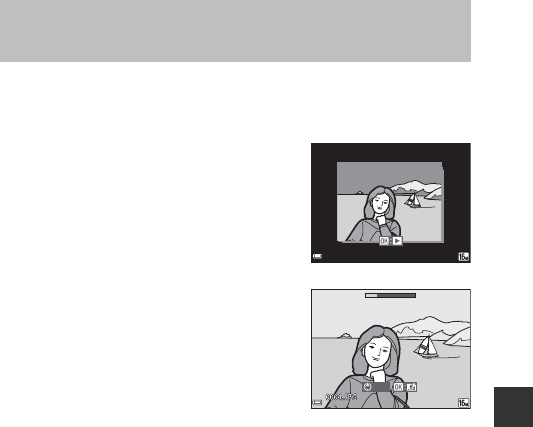
61
Playback Features
Viewing Images in a Sequence
Images captured continuously or with the self-collage function are saved as a
sequence.
The first image of a sequence is used as the key
picture to represent the sequence when
displayed in full-frame playback mode or
thumbnail playback mode. For the self-collage
function, a collage image is used as the key
picture.
To display each image in the sequence
individually, press the k button.
After pressing the k button, the operations
listed below are available.
•To display the previous or next image, press
the multi selector JK.
•To display images that are not included in the
sequence, press H to return to the key
picture display.
•To display images in a sequence as
thumbnails, or to play them back in a slide
show, set Sequence display options to Individual pictures in the
playback menu (A95).
BSequence Display Options
Images captured continuously with cameras other than this camera cannot be
displayed as a sequence.
CPlayback Menu Options Available When Using Sequence
•When images in a sequence are displayed in full-frame playback mode, press the
d button to select functions in playback menu (A91).
•If you press the d button when a key picture is displayed, the following settings
can be applied to all images in the sequence:
- Mark for Wi-Fi upload, Protect, Copy
Viewing and Deleting Images Captured
Continuously (Sequence)
15/11/2015 15:30
15/11/2015 15:30
0004.
JPG
0004.
JPG
1
/
5
1
/
5
1
/
51
/
5
15/11/2015 15:3015/11/2015 15:30
Back

62
Playback Features
Deleting Images in a Sequence
When the l (delete) button is pressed for images in a sequence, the images
that are deleted vary depending on how the sequences are displayed.
•When the key picture is displayed:
•When images in a sequence are displayed in full-frame playback mode:
-Current image: All images in the displayed sequence are
deleted.
-Erase selected images: When a key picture is selected on the erase
selected images screen (A18), all images
in that sequence are deleted.
-All images: All images on the memory card or in the
internal memory are deleted.
-Current image: The image currently displayed is deleted.
-Erase selected images: Images that are selected in the sequence
are deleted.
-Entire sequence: All images in the displayed sequence are
deleted.
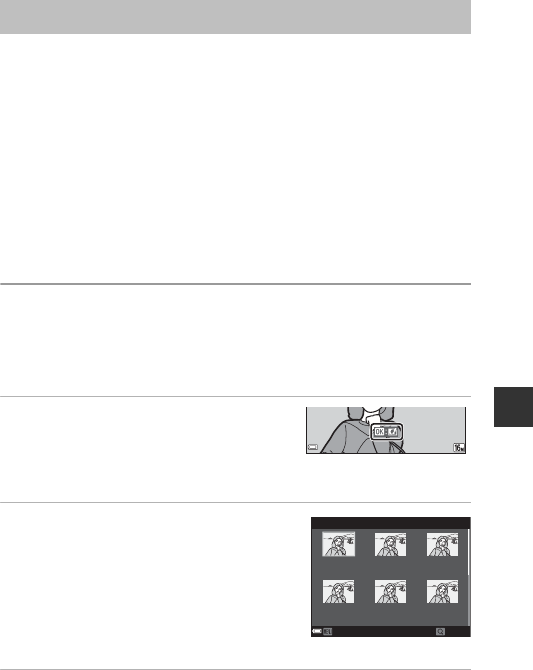
63
Playback Features
Before Editing Images
You can easily edit images on this camera. Edited copies are saved as separate
files.
Edited copies are saved with the same shooting date and time as the original.
CRestrictions on Image Editing
•An image can be edited up to 10 times. Additionally, still images created by movie
editing can be edited up to 9 times.
•You may not be able to edit images of a certain size or with certain editing
functions.
Quick Effects: Changing Hue or Mood
Images can be processed with a variety of effects.
Select Painting, Photo illustration, Soft portrait, Portrait (color + B&W),
Fisheye, Cross screen or Miniature effect.
1Display the image to which you
want to apply an effect in full-
frame playback mode and press
the k button.
2Use the multi selector HIJK to
select the desired effect and press
the k button.
•Move the zoom control (A1) toward g(i)
to switch to full-frame playback or f(h)
to switch to thumbnail playback.
•To exit without saving the edited image,
press the d button.
3Select Yes and press the k button.
•An edited copy is created.
Editing Images (Still Images)
15/11/2015 15:30
15/11/2015 15:30
0004.
JPG
0004.
JPG
CheckCancel
Cross screen
Fisheye
(color + B&W)
Portrait
Soft portrait
illustration
Photo
Painting
Quick eects
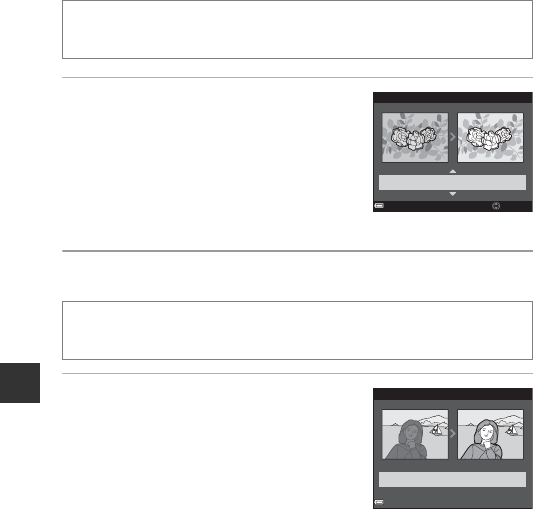
64
Playback Features
Quick Retouch: Enhancing Contrast and Saturation
Use the multi selector HI to select
the amount of effect applied and press
the k button.
•The edited version is displayed on the right.
•To exit without saving the copy, press J.
D-Lighting: Enhancing Brightness and Contrast
Use the multi selector HI to select
OK and press the k button.
•The edited version is displayed on the right.
•To exit without saving the copy, select Cancel
and press the k button.
Press the c button (playback mode) M select an image M d button
M Quick retouch M k button
Press the c button (playback mode) M select an image M d button
M D-Lighting M k button
Amount
Normal
Quick retouch
Cancel
OK
D-Lighting

65
Playback Features
Red-eye Correction: Correcting Red-eye When
Shooting with the Flash
Preview the result and press the k
button.
•To exit without saving the copy, press the multi
selector J.
BNotes About Red-eye Correction
•Red-eye correction can only be applied to images when red-eye is detected.
•Red-eye correction can be applied to pets (dogs or cats) even if their eyes are not
red.
•Red-eye correction may not produce the desired results in some images.
•In rare cases, red-eye correction may be applied unnecessarily to other areas of the
image.
Press the c button (playback mode) M select an image M d button
M Red-eye correction M k button
SaveBack
Red-eye correction

66
Playback Features
Glamour Retouch: Enhancing Human Faces
1Use the multi selector HIJK to
select the face that you want to
retouch and press the k button.
•When only one face is detected, proceed to
step 2.
2Use JK to select the effect, use
HI to select the effect level, and
press the k button.
•You can simultaneously apply multiple
effects.
Adjust or check the settings for all effects
before pressing the k button.
F (Small face), B (Skin softening),
l(Foundation makeup), m (Glare reduction), E (Hide eye bags), A (Big
eyes), G (Whiten eyes), n (Eye shadow), o (Mascara), H (Whiten teeth),
p (Lipstick), D (Redden cheeks)
•Press the d button to return to the screen for selecting a person.
3Preview the result and press the
k button.
•To change the settings, press J to return to
step 2.
•To exit without saving the edited image,
press the d button.
Press the c button (playback mode) M select an image M d button
M Glamour retouch M k button
Back
Subject selection
3
2
1
Back
Small face
Save
Preview
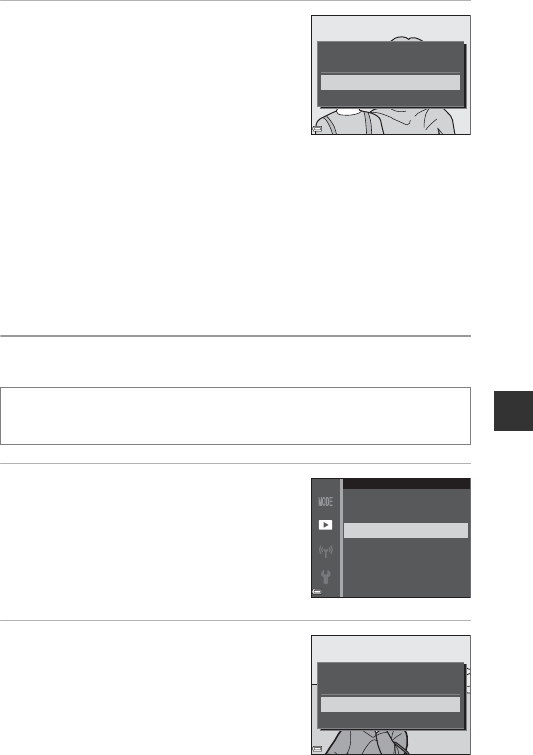
67
Playback Features
4Select Yes and press the k
button.
•An edited copy is created.
BNotes About Glamour Retouch
•One face at a time can be edited. To use the glamour retouch function for another
face, edit the edited image again.
•Depending on the direction in which faces are looking, or the brightness of faces,
the camera may be unable to accurately detect faces, or the glamour retouch
function may not perform as expected.
•If no faces are detected, a warning is displayed and the screen returns to the
playback menu.
•The glamour retouch function is available only for images captured at an ISO
sensitivity of 1600 or lower, and the image size of 640 × 480 or larger.
Small Picture: Reducing the Size of an Image
1Use the multi selector HI to
select the desired copy size and
press the k button.
•Images captured at an image mode setting of
l 4608×2592 are saved at a size of 640 ×
360, and images captured at an image mode
setting of s 3456×3456 are saved at 480 ×
480. Press the k button to proceed to step 2.
2Select Yes and press the k
button.
•An edited copy is created (compression
ratio of approximately 1:8).
Press the c button (playback mode) M select an image M d button
M Small picture M k button
No
Yes
Save OK?
160×120
320×240
640×480
Small picture
No
Yes
Create small picture le?

68
Playback Features
Crop: Creating a Cropped Copy
1Move the zoom control to enlarge the image (A58).
2Adjust the image so that only the
portion that you want to keep is
displayed, and then press the d
(menu) button.
•Move the zoom control toward g(i) or
f(h) to adjust the magnification rate.
Set a magnification rate at which u is
displayed.
•Use the multi selector HIJK to scroll to the portion of the image that you
want to display.
3Preview the image and press the
k button.
•To change the portion that you want to
keep, press J to return to step 2.
•To exit without saving the cropped image,
press the d button.
4Select Yes and press the k
button.
•An edited copy is created.
CImage Size
•The aspect ratio (horizontal to vertical) of a cropped image is the same as that of
the original image.
•When the image size of the cropped copy is 320 × 240 or smaller, the image is
displayed at a smaller size during playback.
3.0
3.0
Back Save
Trim
No
Yes
displayed?
Save this image as
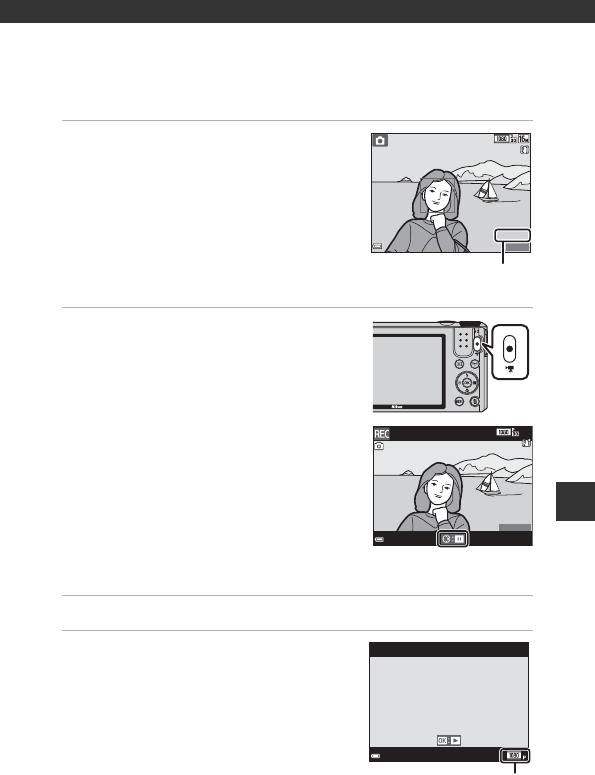
69
Recording and Playing Back Movies
Recording and Playing Back
Movies
1Display the shooting screen.
•Check the remaining amount of movie
recording time.
2Press the b (e movie-record)
button to start movie recording.
•The camera focuses in the center of the
frame.
•Press the multi selector K to pause
recording, and press K again to resume
recording (except when an HS movie
option is selected in Movie options).
Recording automatically ends if it remains
paused for about five minutes.
•You can capture a still image by pressing
the shutter-release button while recording
a movie (A72).
3Press the b (e ) button again to end recording.
4Select a movie in full-frame
playback mode and press the k
button to play it back.
•An image with a movie options icon is a
movie.
25
m
0s
25
m
0s
880
880
Remaining movie
recording time
14
m
3
0s14
m
3
0s
15/11/2015 15:30
15/11/2015 15:30
0010.
MOV
0010.
MOV
10s
10s
Movie options

70
Recording and Playing Back Movies
Area Captured in Movies
•The area that is captured in a movie varies depending on the Movie
options or Movie VR settings in the movie menu.
•If Photo info in Monitor settings (A108) in the setup menu is set to
Movie frame+auto info, you can confirm the area that will be captured in
a movie before you start recording.
Maximum Movie Recording Time
Individual movie files cannot exceed 4 GB in size or 29 minutes in length, even
when there is sufficient free space on the memory card for longer recording.
•The remaining recording time for a single movie is displayed on the
shooting screen.
•The actual remaining recording time may vary depending on the movie
content, subject movement, or type of memory card.
•Memory cards with an SD Speed Class rating of 6 or faster are
recommended when recording movies (A153). Movie recording may stop
unexpectedly when memory cards with a lower Speed Class rating are used.
•When using the camera’s internal memory, saving movies may take some
time.
•Depending on the file size of a movie, it may not be possible to save the
movie in the internal memory or copy it from a memory card to the internal
memory.
BNotes About Camera Temperature
•The camera may become hot when shooting movies for an extended period of
time or when the camera is used in a hot area.
•If the inside of the camera becomes extremely hot when recording movies, the
camera will automatically stop recording.
The amount of time remaining until the camera stops recording (B10s) is
displayed.
After the camera stops recording, it turns itself off.
Leave the camera off until the inside of the camera has cooled.

71
Recording and Playing Back Movies
Notes About Movie Recording
BNotes About Saving Images or Movies
The indicator showing the number of exposures remaining or the indicator showing
the remaining recording time flashes while images or movies are being saved. Do
not open the battery-chamber/memory card slot cover or remove the
battery or memory card while an indicator is flashing. Doing this could result in
loss of data, or in damage to the camera or the memory card.
BNotes About Recorded Movies
•There may be some degradation in image quality when digital zoom is used.
•The sounds of zoom control operation, zoom, autofocus lens drive movement,
movie vibration reduction, and aperture operation when brightness changes may
be recorded.
•The following phenomena may be seen in the monitor while recording movies.
These phenomena are saved in the recorded movies.
- Banding may occur in images under fluorescent, mercury-vapor, or sodium-
vapor lighting.
- Subjects that move quickly from one side of the frame to the other, such as a
moving train or car, may appear skewed.
- The entire movie image may be skewed when the camera is panned.
- Lighting or other bright areas may leave residual images when the camera is
moved.
•Depending on the distance to the subject or the amount of zoom applied, colored
stripes may appear on subjects with repeating patterns (fabrics, lattice windows,
etc.) during movie recording and playback. This occurs when the pattern in the
subject and the layout of the image sensor interfere with each other; it is not a
malfunction.
BNotes About Vibration Reduction During Movie Recording
•When Movie VR (A102) in the movie menu is set to On (hybrid), the angle of
view (i.e., the area visible in the frame) becomes narrower during movie recording.
•When using a tripod to stabilize the camera during shooting, set Movie VR to Off
to prevent potential errors caused by this function.
BNotes About Autofocus for Movie Recording
Autofocus may not perform as expected (A54). Should this occur, try the following:
1. Set Autofocus mode in the movie menu to Single AF (default setting) before
starting movie recording.
2. Frame another subject (positioned at the same distance from the camera as the
intended subject) in the center of the frame, press the b (e) button to start
recording, and modify the composition.
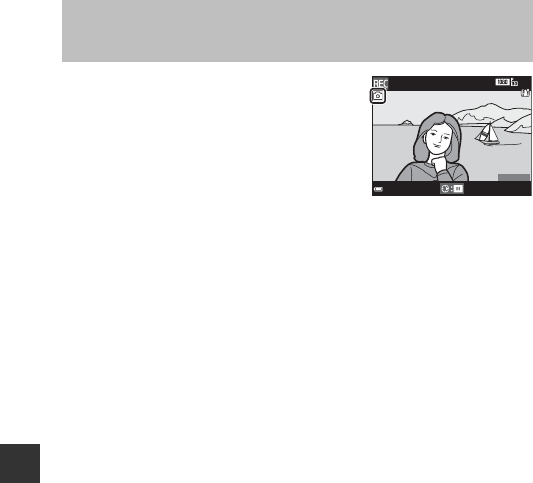
72
Recording and Playing Back Movies
If the shutter-release button is pressed all the
way while recording a movie, one frame is saved
as a still image. Movie recording continues while
the still image is being saved.
•While Q is displayed in the monitor, still
images can be captured. While z is
displayed, still images cannot be captured.
•The size of the captured image varies
depending on the Movie options setting
(A97).
BNotes About Capturing Still Images During Movie Recording
•Still images cannot be captured during a movie recording in the following
situations:
- When the remaining movie recording time is less than 5 seconds
- When Movie options is set to Z 1080/60i, U 1080/50i, g 480/30p,
W 480/25p, or HS movie
•The sound of pressing the shutter-release button may be recorded in the movie.
•If the camera moves when the shutter-release button is pressed, the image may be
blurred.
Capturing Still Images While Recording
Movies
14
m
3
0s14
m
3
0s
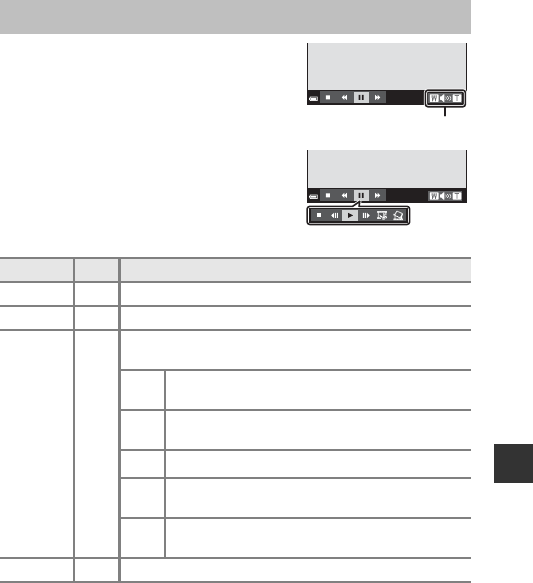
73
Recording and Playing Back Movies
To adjust the volume, move the zoom control
while a movie is playing (A1).
Playback controls are displayed in the monitor.
The operations described below can be
performed by using the multi selector JK to
select a control and then pressing the k
button.
Operations During Movie Playback
Function Icon Description
Rewind AHold down the k button to rewind the movie.
Advance BHold down the k button to advance the movie.
Pause E
Pause playback. The operations listed below can be
performed while paused.
CRewind the movie one frame. Hold down the k
button for continuous rewinding.
DAdvance the movie one frame. Hold down the k
button for continuous advancing.
FResume playback.
IExtract the desired portion of a movie and save it as a
separate file.
HExtract a single frame of a movie and save it as a still
image.
End GReturn to full-frame playback mode.
Volume indicator
When
paused
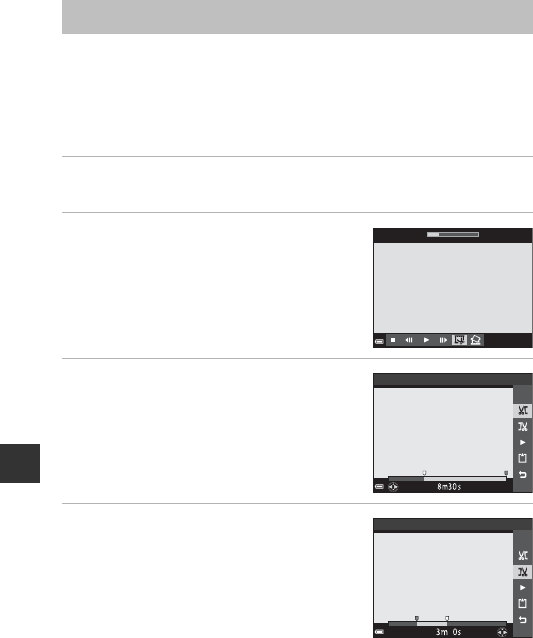
74
Recording and Playing Back Movies
When editing movies, use a sufficiently charged battery to prevent the camera
from turning off during editing. When the battery level indicator is B, movie
editing is not possible.
Extracting Only the Desired Portion of a Movie
The desired portion of a recorded movie can be saved as a separate file.
1Play back a movie and pause at the start point of the
portion that you want to extract (A73).
2Use the multi selector JK to
select I in the playback controls,
and then press the k button.
3Use HI to select M (choose start
point) in the editing controls.
•Use JK to move the start point.
•To cancel editing, select O (return), and
press the k button.
4Use HI to select N (choose end
point).
•Use JK to move the end point.
•To preview the specified portion, select G
and then press the k button. Press the k
button again to stop previewing.
Editing Movies
1m30s
1m30s
Choose start point
Choose end point
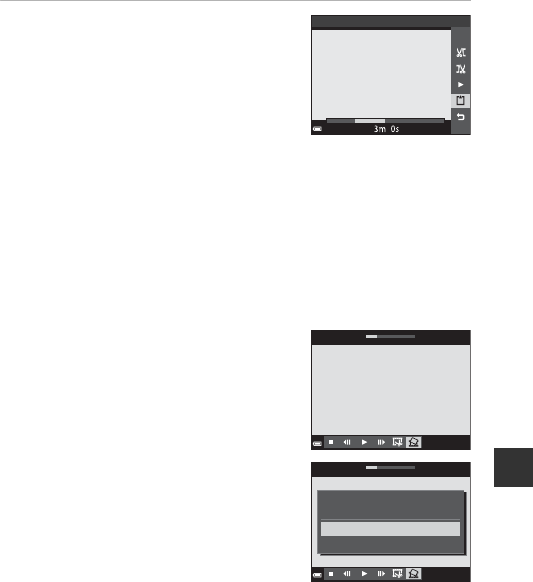
75
Recording and Playing Back Movies
5Use HI to select m (save) and
press the k button.
•Follow the instructions on the screen to
save the movie.
BNotes About Movie Editing
•A movie that was created by editing cannot be trimmed again.
•The actual trimmed portion of a movie may differ slightly from the portion selected
using the start and end points.
•Movies cannot be trimmed so that they are less than two seconds long.
Saving a Frame from a Movie as a Still Image
The desired frame of a recorded movie can be extracted and saved as a still
image.
•Pause a movie and display the frame to be
extracted (A73).
•Use the multi selector JK to select the H
control and press the k button.
•Select Yes when a confirmation dialog is
displayed, and press the k button to save
the image.
•The image quality of the saved still image is
normal (compression ratio of approximately
1:8). The image size is determined by the type
(image size) (A97) of the original movie.
For example, a still image saved from a movie
recorded with e 1080/30p or S
1080/25p is n (1920 × 1080 pixels).
BNotes About Saving Still Images
Frames of HS movies and movies recorded with Z 1080/60i, U 1080/50i,
g 480/30p , or W 480/25p (A98) cannot be saved as still images.
Save
1m30s
1m30s
1m30s
1m30s
No
Yes
Copy this frame as a still image?
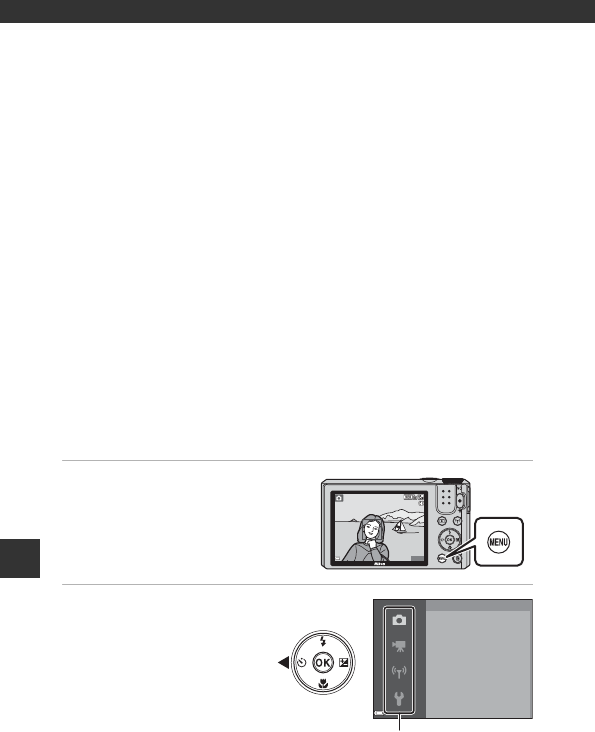
76
Using Menus
Using Menus
You can set the menus listed below by pressing the d (menu) button.
•A, x, y, X, W, u, F, n Shooting menu
Available by pressing the d button when the shooting screen is
displayed.
Allows you to change image size and quality, continuous shooting settings,
etc.
Menu icons and setting items vary depending on the shooting mode.
•G Playback menu/C List by date menu
Available by pressing the d button when viewing images in full-frame
playback mode or thumbnail playback mode.
Allows you to edit images, play slide shows, etc.
•D Movie menu
Available by pressing the d button when the shooting screen is
displayed.
Allows you to change movie recording settings.
•J Wi-Fi options menu
Allows you to configure Wi-Fi settings for connecting the camera and a
smart device.
•z Setup menu
Allows you to adjust basic camera functions such as date and time, display
language, etc.
1Press the d (menu)
button.
•The menu is displayed.
2Press the multi
selector J.
•The current menu icon is
displayed in yellow.
25
m
0s
25
m
0s
880
880
Autofocus mode
AF area mode
ISO sensitivity
Continuous
White balance
Image mode
Shooting menu
Menu icons
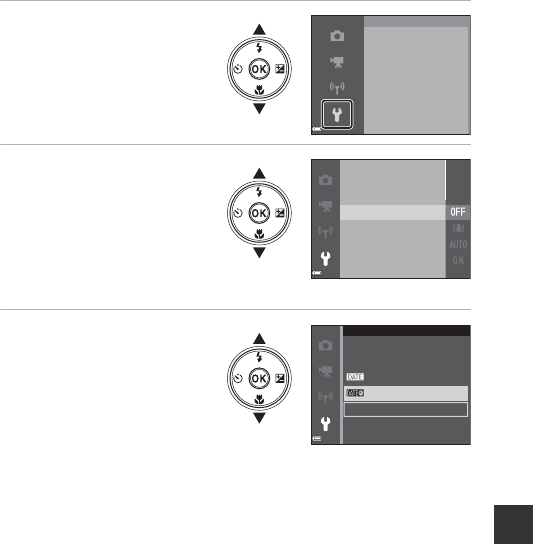
77
Using Menus
3Select a menu icon
and press the k
button.
•The menu options
become selectable.
4Select a menu option
and press the k
button.
•Certain menu options
cannot be set depending
on the current shooting
mode or the state of the
camera.
5Select a setting and
press the k button.
•The setting you selected is
applied.
•When you are finished
using the menu, press the
d button.
•When a menu is displayed,
you can switch to shooting mode by pressing the shutter-release button or
b (e) button.
Digital zoom
AF assist
Photo VR
Date stamp
Monitor settings
Time zone and date
Set up
Digital zoom
AF assist
Photo VR
Date stamp
Monitor settings
Time zone and date
O
Date and time
Date
Date stamp
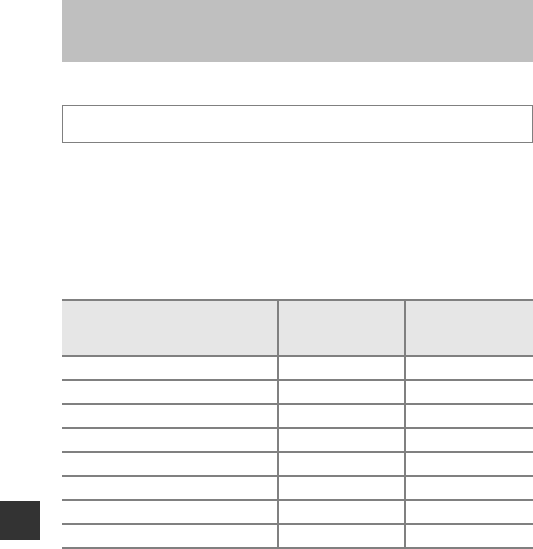
78
Using Menus
Image Mode (Image Size and Quality)
* This setting can also be changed in shooting modes other than short movie show
mode. The changed setting is also applied to other shooting modes (except
Time-lapse movie and Easy panorama scene modes).
Select the combination of image size and compression ratio to be used when
saving images.
The higher the image mode setting, the larger the size at which it can be
printed, and the lower the compression ratio, the higher the quality of the
images, but the number of images that can be saved is reduced.
* The numerical values indicate the number of pixels that are captured.
Example: P 4608×3456 = approx. 16 megapixels, 4608 × 3456 pixels
The Shooting Menu (The Common
Shooting Options)
Enter shooting mode* M d button M Image mode M k button
Option* Compression ratio
Aspect ratio
(horizontal to
vertical)
Q 4608×3456PApprox. 1:4 4:3
P 4608×3456 (default setting) Approx. 1:8 4:3
R 3264×2448 Approx. 1:8 4:3
r 2272×1704 Approx. 1:8 4:3
q 1600×1200 Approx. 1:8 4:3
O 640×480 Approx. 1:8 4:3
l 4608×2592 Approx. 1:8 16:9
s 3456×3456 Approx. 1:8 1:1

79
Using Menus
BNotes About Printing Images at 1:1 Aspect Ratio
Change the printer setting to “Border” when printing images at a 1:1 aspect ratio.
Some printers may not be able to print images at a 1:1 aspect ratio.
BNotes About Image Mode
This function may not be available to use in combination with other functions
(A56).
CNumber of Images That Can Be Saved
•The approximate number of images that can be saved can be checked in the
monitor when shooting (A12).
•Note that due to JPEG compression, the number of images that can be saved may
vary greatly depending on the image content, even when using memory cards
with the same capacity and the same image mode setting. In addition, the number
of images that can be saved may vary depending on the make of the memory card.
•If the number of exposures remaining is 10,000 or more, the number of exposures
remaining display shows “9999”.
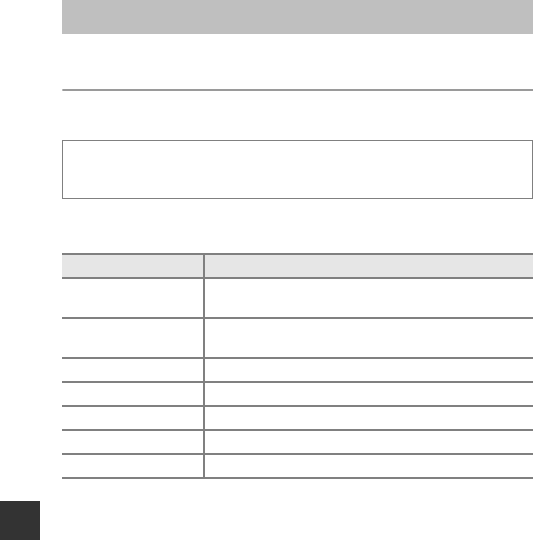
80
Using Menus
•See “Image Mode (Image Size and Quality)” (A78) for information about
Image mode.
White Balance (Adjusting Hue)
Adjust white balance to suit the light source or weather conditions in order to
make the colors in images match what you see with your eyes.
BNotes About White Balance
•Set the flash to W (off) when white balance is set to any setting other than Auto
and Flash (A41).
•This function may not be available to use in combination with other functions
(A56).
The Shooting Menu (for A (Auto) Mode)
Rotate the mode dial to A M d button M A menu icon M White
balance M k button
Option Description
aAuto
(default setting) White balance is automatically adjusted.
bPreset manual Use when the desired result is not achieved with Auto,
Incandescent, etc. (A81).
cDaylight Use under direct sunlight.
dIncandescent Use under incandescent lighting.
eFluorescent Use under fluorescent lighting.
fCloudy Use under overcast skies.
gFlash Use with the flash.
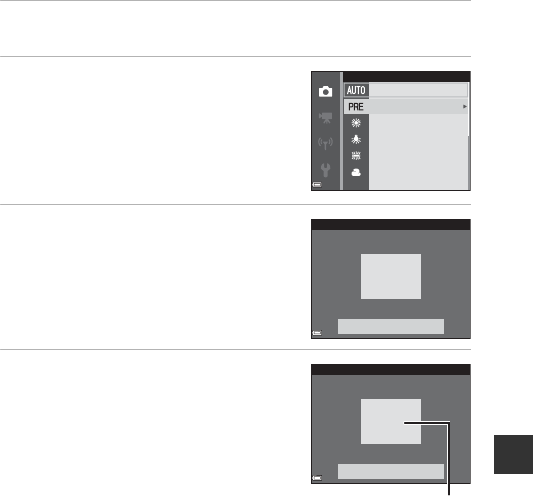
81
Using Menus
Using Preset Manual
Use the procedure below to measure the white balance value under the
lighting used during shooting.
1Place a white or gray reference object under the lighting
that will be used during shooting.
2Use the multi selector HI to
select Preset manual in the
White balance menu, and press
the k button.
•The camera zooms in to the position for
measuring white balance.
3Select Measure.
•To apply the last measured value, select
Cancel and press the k button.
4Frame the white or gray reference
object in the measuring window,
and press the k button to
measure the value.
•The shutter is released and measurement is
complete (no image is saved).
BNotes About Preset Manual
A value for flash lighting cannot be measured with Preset manual. When shooting
using the flash, set White balance to Auto or Flash.
Preset manual
Cloudy
Cloudy
Fluorescent
Fluorescent
Incandescent
Incandescent
Daylight
Daylight
Auto
Auto
Cloudy
Fluorescent
Incandescent
Daylight
Auto
White balance
Measure
Cancel
Preset manual
Measure
Cancel
Preset manual
Measuring window

82
Using Menus
Continuous Shooting
Rotate the mode dial to A M d button M A menu icon M
Continuous M k button
Option Description
USingle
(default setting)
One image is captured each time the shutter-release
button is pressed.
k Continuous H
While the shutter-release button is held all the way down,
images are captured continuously.
•The frame rate for continuous shooting is about 7.9 fps
and the maximum number of continuous shots is about
7 (when image mode is set to P 4608×3456).
m Continuous L
While the shutter-release button is held all the way down,
images are captured continuously.
•The frame rate for continuous shooting is about 2 fps and
the maximum number of continuous shots is about 7
(when image mode is set to P 4608×3456).
q Pre-shooting
cache
When the shutter-release button is pressed halfway, pre-
shooting cache shooting begins. When the shutter-release
button is pressed the rest of the way down, the camera
saves the current image as well as the images captured
immediately before the button is pressed (A83). This
function helps you to avoid missing the shot.
•The frame rate for continuous shooting is about 15 fps
and the maximum number of continuous shots is 25,
including a maximum of 4 frames captured in the pre-
shooting cache.
•Image mode is fixed at q 1600×1200.
n Continuous H:
120 fps
Each time the shutter-release button is pressed all the way,
images are captured at a high speed rate.
•The frame rate for continuous shooting is about 120 fps
and the maximum number of continuous shots is 50.
•Image mode is fixed at O 640×480.
j Continuous H:
60 fps
Each time the shutter-release button is pressed all the way,
images are captured at a high speed rate.
•The frame rate for continuous shooting is about 60 fps
and the maximum number of continuous shots is 25.
•Image mode is fixed at M (image size: 1280 × 960
pixels).
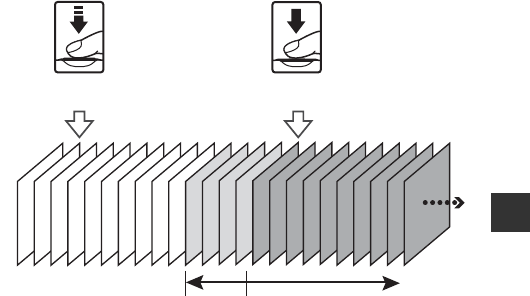
83
Using Menus
BNotes About Continuous Shooting
•Focus, exposure, and white balance are fixed at the values determined with the
first image in each series.
•It may take some time to save the images after shooting.
•When ISO sensitivity increases, noise may appear in captured images.
•The frame rate for continuous shooting may vary depending on the current image
mode setting, the memory card used, or shooting condition.
•When using Pre-shooting cache, Continuous H: 120 fps, or Continuous H: 60
fps, banding or variance in brightness or hue may occur in images that were
captured under lighting that flickers at high speeds, such as fluorescent, mercury-
vapor, or sodium-vapor lighting.
•This function may not be available to use in combination with other functions
(A56).
CPre-shooting Cache
When the shutter-release button is pressed halfway or all the way down, images are
saved as described below.
•The pre-shooting cache icon (Q) on the shooting screen changes to green while
the shutter-release button is pressed halfway.
Images saved before pressing all the way Images saved by pressing all
the way
Press down halfway Press down all the way
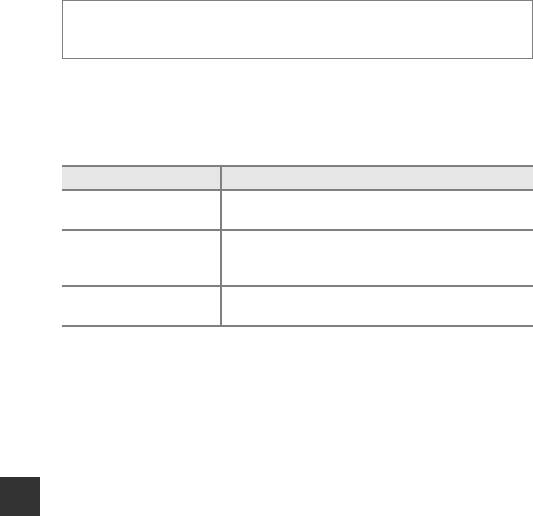
84
Using Menus
ISO Sensitivity
A higher ISO sensitivity allows darker subjects to be captured. Additionally,
even with subjects of similar brightness, pictures can be taken at faster shutter
speeds, and blurring caused by camera shake and subject movement can be
reduced.
•When a higher ISO sensitivity is set, images may contain noise.
BNotes About ISO Sensitivity
This function may not be available to use in combination with other functions
(A56).
CISO Sensitivity Display on the Shooting Screen
•When Auto is selected, E is displayed when the ISO sensitivity increases.
•When Fixed range auto is selected, the maximum value for ISO sensitivity
is displayed.
Rotate the mode dial to A M d button M A menu icon M ISO
sensitivity M k button
Option Description
a Auto
(default setting)
Sensitivity is automatically selected from the range of
ISO 125 to 1600.
I Fixed range auto
Select the range in which the camera automatically
adjusts ISO sensitivity, from ISO 125-400 or ISO 125-
800.
125, 200, 400, 800, 1600,
3200, 6400 Sensitivity is locked at the specified value.
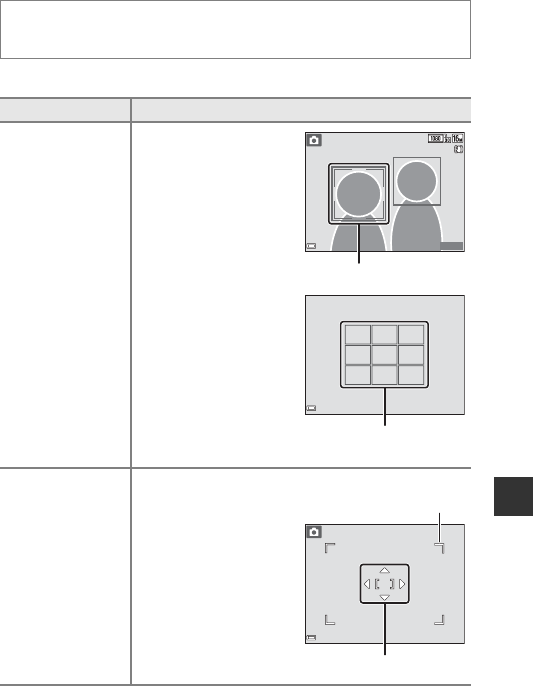
85
Using Menus
AF Area Mode
Set how the camera selects the focus area for autofocus.
Rotate the mode dial to A M d button M A menu icon M AF area
mode M k button
Option Description
aFace priority
When the camera detects
a human face, it focuses
on that face.
See “Using Face
Detection” (A53) for
more information.
When framing a
composition with no
human subjects or
detected faces, the
camera automatically
selects one or more of the
9 focus areas containing
the subject closest to the
camera when the shutter-
release button is pressed
halfway.
xManual
Use the multi selector
HIJK to move the
focus area to where you
want to focus.
•To use the multi
selector to configure
the flash mode or other
settings, press the k
button. To return to
moving the focus area,
press the k button
again.
880
880
25
m
0s
25
m
0s
Focus area
F3.4
F3.4
1/250
1/250
Focus areas
Scope of movable
focus area
Focus area
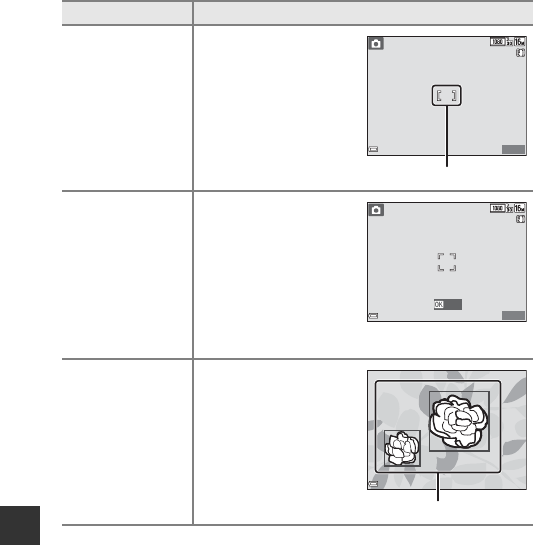
86
Using Menus
BNotes About AF Area Mode
•When digital zoom is in effect, the camera focuses in the center of the frame
regardless of the AF area mode setting.
•This function may not be available to use in combination with other functions
(A56).
yCenter
The camera focuses on
the subject in the center
of the frame.
s Subject
tracking
Use this function to take
pictures of moving
subjects. Register the
subject on which the
camera focuses. The focus
area automatically moves
to track the subject. See
“Using Subject Tracking”
(A87) for more
information.
M Target finding
AF (default setting)
When the camera detects
the main subject, it
focuses on that subject.
See “Using Target Finding
AF” (A52) for more
information.
Option Description
25
m
0s
25
m
0s
880
880
Focus area
880
880
25
m
0s
25
m
0s
Start
F3.4
F3.4
1/250
1/250
Focus areas
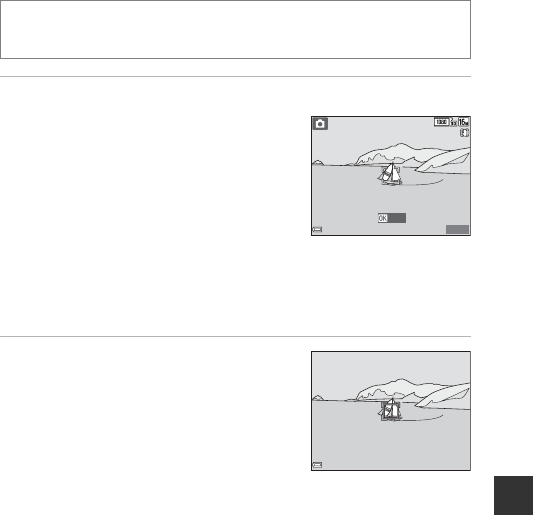
87
Using Menus
Using Subject Tracking
1Register a subject.
•Align the subject that you want to track
with the border in the center of the monitor
and press the k button.
•When the subject is registered, a yellow
border (focus area) is displayed around it
and the camera begins tracking the subject.
•If the subject cannot be registered, the
border is displayed in red. Change the
composition and try registering the subject
again.
•To cancel subject registration, press the k button.
•If the camera can no longer track the registered subject, the focus area
disappears. Register the subject again.
2Press the shutter-release button
fully to take the picture.
•If the shutter-release button is pressed
while the focus area is not displayed, the
camera focuses on the subject in the center
of the frame.
BNotes About Subject Tracking
•If you perform operations such as zooming while the camera is tracking the
subject, the registration is canceled.
•Subject tracking may not be possible in certain shooting conditions.
Rotate the mode dial to A M d button M A menu icon M AF area
mode M k button M s Subject tracking M k button M d button
880
880
25
m
0s
25
m
0s
Start
F3.4
F3.4
1/250
1/250
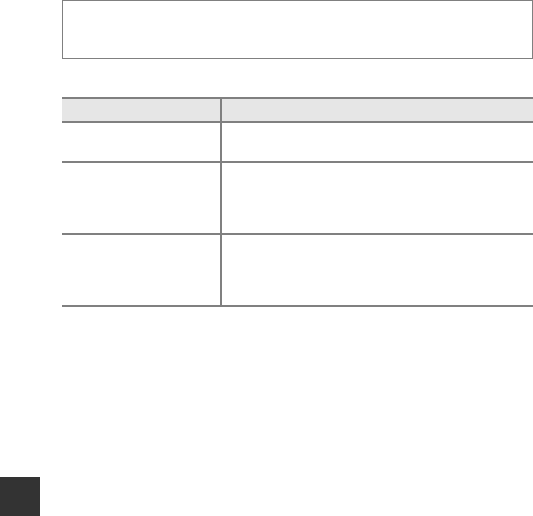
88
Using Menus
Autofocus Mode
Set how the camera focuses when shooting still images.
CAutofocus Mode for Short Movie Show Mode or Movie Recording
Autofocus mode for short movie show mode or movie recording can be set with
Autofocus mode (A101) in the movie menu.
Rotate the mode dial to A M d button M A menu icon M Autofocus
mode M k button
Option Description
ASingle AF The camera focuses only when the shutter-release
button is pressed halfway.
BFull-time AF
The camera continues focusing even when the
shutter-release button is not pressed halfway. The
sound of lens drive movement is heard while the
camera focuses.
a Pre-focus
(default setting)
Even when the shutter-release button is not pressed
halfway, the camera focuses automatically if the
composition of the framed image is significantly
changed.
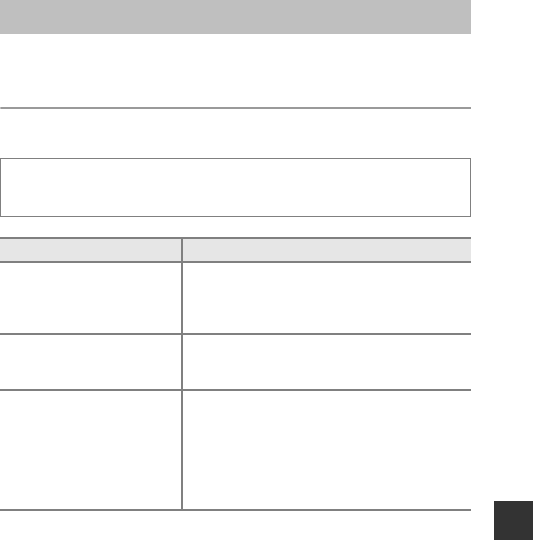
89
Using Menus
•See “Image Mode (Image Size and Quality)” (A78) for information about
Image mode.
Self-Collage
The Smart Portrait Menu
Rotate the mode dial to F M d button M F menu icon M
Self-Collage M k button
Option Description
Number of shots
Set the number of shots that the camera
automatically captures (number of captured
images for an aggregated image).
•4 (default setting) or 9 can be selected.
Interval
Set the interval time between each shot.
•Short, Medium (default setting), or Long can
be selected.
Shutter sound
Set whether to activate the shutter sound when
shooting with the self-collage function.
•Standard, SLR, Magic (default setting), or Off
can be selected.
•The same setting that is specified for Shutter
sound in Sound settings in the setup menu is
not applied to this setting.
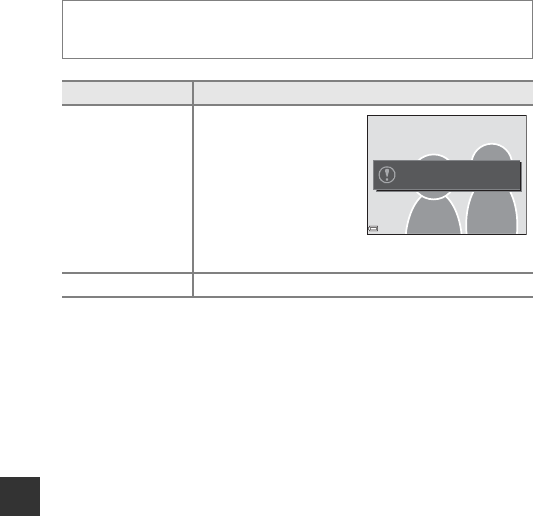
90
Using Menus
Blink Proof
BNotes About Blink Proof
This function may not be available to use in combination with other functions
(A56).
Rotate the mode dial to F M d button M F menu icon M Blink proof
M k button
Option Description
y On
The camera automatically
releases the shutter twice
with every shot and saves
one image in which the
subject’s eyes are open.
•If the camera saved an
image in which the
subject’s eyes may
have been closed, the
dialog shown on the right is displayed for a few seconds.
Off (default setting) Turns the blink proof off.
picture just taken.
A blink was detected in the

91
Using Menus
•See “Editing Images (Still Images)” (A63) for information about image
editing functions.
Mark for Wi-Fi Upload
Select still images in the camera that you want to transfer to a smart device in
advance before transferring them. Movies cannot be selected.
On the image selection screen (A96), select or deselect images for the Mark
for Wi-Fi upload function.
Note that when you select Reset all (A116) in the setup menu or Restore
default settings (A104) in the Wi-Fi options menu, the Mark for Wi-Fi
upload settings that you made are canceled.
The Playback Menu
Press the c button (playback mode) M d button M Mark for Wi-Fi
upload M k button
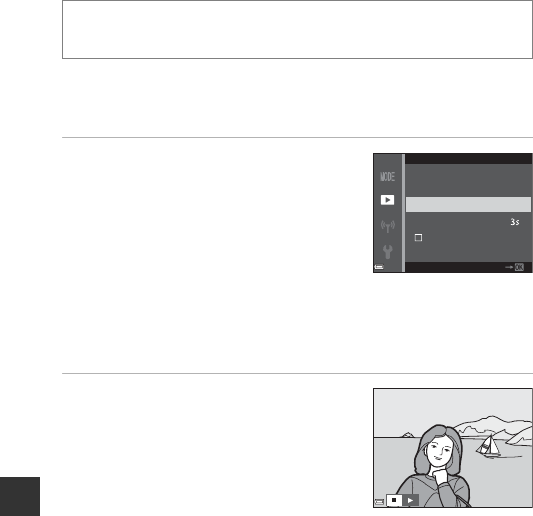
92
Using Menus
Slide Show
Play back images one by one in an automated “slide show.” When movie files
are played back in the slide show, only the first frame of each movie is
displayed.
1Use the multi selector HI to
select Start and press the k
button.
•The slide show begins.
•To change the interval between images,
select Frame intvl, press the k button,
and specify the desired interval time before
selecting Start.
•To repeat the slide show automatically, select Loop and press the k button
before selecting Start.
•The maximum playback time is up to about 30 minutes even if Loop is
enabled.
2End or restart the slide show.
•The screen shown on the right is displayed
after the slide show ends or is paused. To
exit the show, select G and then press the
k button. To resume the slide show, select
F and then press the k button.
Operations During Playback
•Use the multi selector JK to display the previous/next image. Press and
hold to rewind/fast forward.
•Press the k button to pause or end the slide show.
Press the c button (playback mode) M d button M Slide show M k
button
Pause
Loop
Frame intvl
Start
Slide show
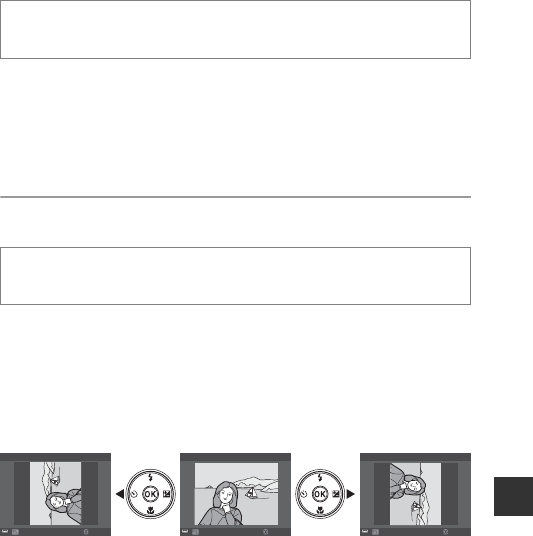
93
Using Menus
Protect
The camera protects selected images from accidental deletion.
Select images to protect or cancel protection from the image selection screen
(A96).
Note that formatting the memory card or the camera’s internal memory
permanently deletes all data including protected files (A114).
Rotate Image
Specify the orientation in which saved images are displayed during playback.
Still images can be rotated 90 degrees clockwise or 90 degrees
counterclockwise.
Select an image from the image selection screen (A96). When the Rotate
image screen is displayed, press the multi selector JK to rotate the image 90
degrees.
Press the k button to finalize display orientation, and save orientation
information with the image.
Press the c button (playback mode) M d button M Protect M k
button
Press the c button (playback mode) M d button M Rotate image M
k button
RotateBack
Rotate image
RotateBack
Rotate image
RotateBack
Rotate image
Rotate 90 degrees
counterclockwise
Rotate 90 degrees
clockwise
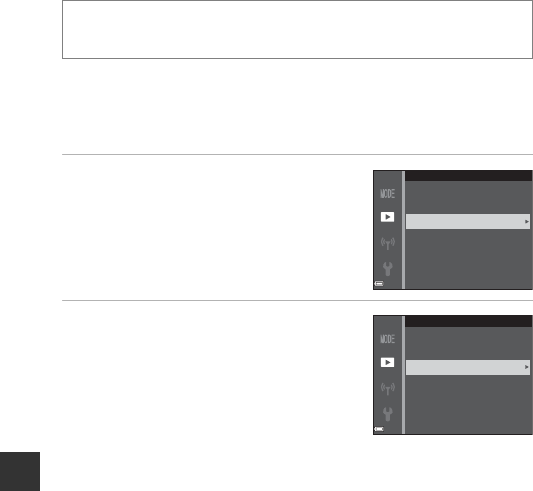
94
Using Menus
Copy (Copy Between the Memory Card and
Internal Memory)
Images can be copied between a memory card and the internal memory.
•When a memory card that contains no images is inserted and the camera is
switched to playback mode, Memory contains no images. is displayed. In
that case, press the d button to select Copy.
1Use the multi selector HI to
select a destination option to
which images are copied and
press the k button.
2Select a copy option and press the
k button.
•When you choose Selected images, use the
image selection screen to specify images
(A96).
BNotes About Copying Images
•Only files in formats that this camera can record can be copied.
•Operation is not guaranteed with images captured with another make of camera
or that have been modified on a computer.
CCopying Images in a Sequence
•If you select a key picture of a sequence in Selected images, all images in the
sequence are copied.
•If you press the d button while images in a sequence are displayed, only the
Card to camera copy option is available. All images in the sequence are copied if
you select Current sequence.
Press the c button (playback mode) M d button M Copy M k
button
Card to camera
Camera to card
Copy
All images
Selected images
Camera to card
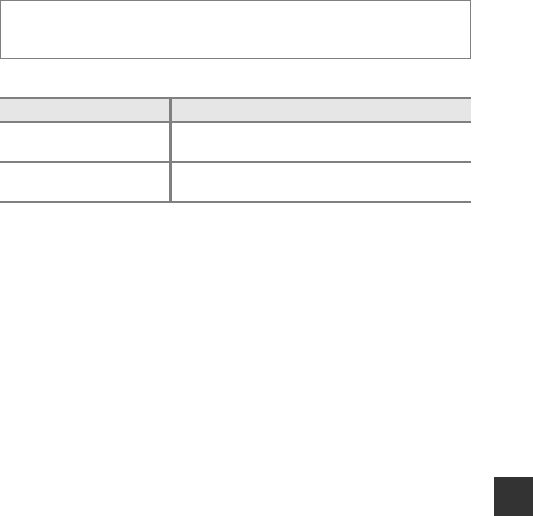
95
Using Menus
Sequence Display Options
Select the method used to display images in the sequence (A61).
The setting is applied to all sequences and saved in the camera’s memory even
if the camera is turned off.
Press the c button (playback mode) M d button M Sequence display
options M kbutton
Option Description
Q Individual pictures Displays each image in a sequence individually.
Fis displayed on the playback screen.
C Key picture only
(default setting)
Displays only the key picture for images in a
sequence.
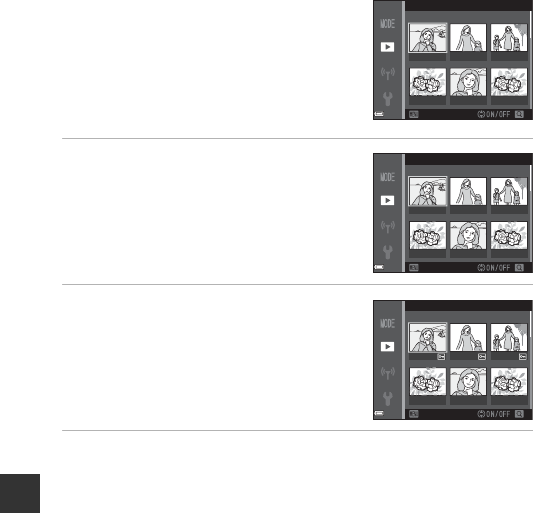
96
Using Menus
The Image Selection Screen
When an image selection screen such as the
one shown on the right is displayed while
operating the camera, follow the procedures
described below to select the images.
1Use the multi selector JK to
select an image.
•Move the zoom control (A1) toward g(i)
to switch to full-frame playback or f(h)
to switch to thumbnail playback.
•Only one image can be selected for Rotate
image. Proceed to step 3.
2Use HI to select or deselect.
•When an image is selected, an icon is
displayed below the image. Repeat steps 1
and 2 to select additional images.
3Press the k button to apply image selection.
•When a confirmation dialog is displayed, follow the on-screen instructions to
operate.
Back
Protect
Back
Protect
Back
Protect
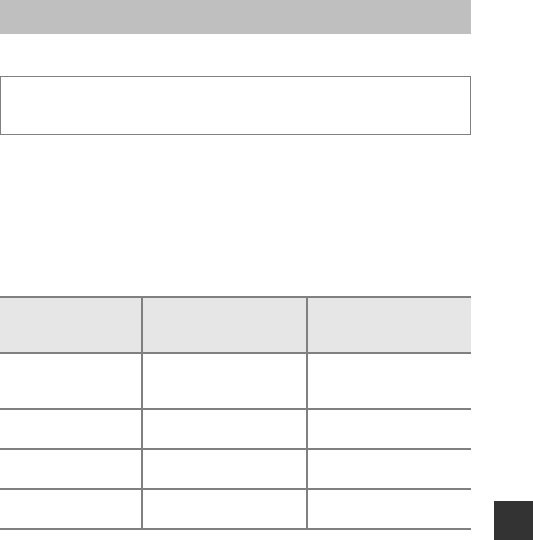
97
Using Menus
Movie Options
Select the desired movie option to record. Select normal speed movie options
to record at normal speed, or HS movie options (A98) to record in slow or fast
motion. The movie options that can be selected vary depending on the Frame
rate setting (A103) in the movie menu.
•
Memory cards with an SD Speed Class rating of 6 or faster are recommended
for recording movies (
A
153).
Normal Speed Movie Options
1Interlaced format uses Fields per second.
2The setting is not available when using certain effects in special effects mode or
glamour retouch function.
The Movie Menu
Enter shooting mode M d button M D menu icon M Movie options
M k button
Option
(Image size/Frame
rate1, File format)
Image size Aspect ratio (horizontal to
vertical)
e 1080/30p
S 1080/25p
(default setting)
1920 × 1080 16:9
Z 1080/60i1, 2
U 1080/50i1, 2 1920 × 1080 16:9
f 720/30p
V 720/25p 1280 × 720 16:9
g 480/30p
W 480/25p 640 × 480 4:3
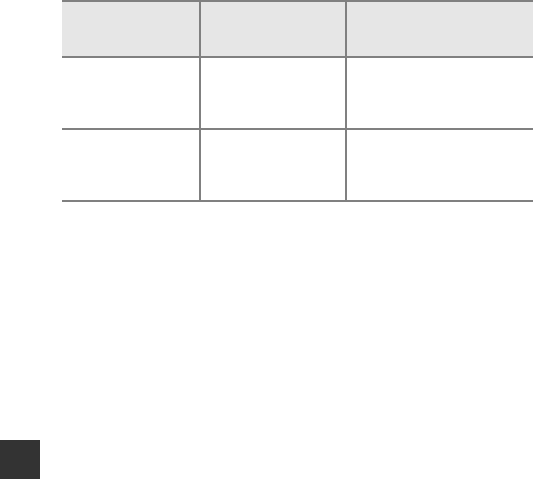
98
Using Menus
HS Movie Options
Recorded movies are played back in fast or slow motion.
See “Recording Movies in Slow Motion and Fast Motion (HS Movie)” (A100).
1The setting is not available when using certain effects in special effects mode or
glamour retouch function.
2While recording movies, the camera can be switched between normal speed
movie recording and slow motion or fast motion movie recording.
The maximum recording time shown here refers only to the portion of the movie
that is recorded in slow motion or fast motion.
BNotes About HS Movie
•Sound is not recorded.
•Zoom position and focus are locked when movie recording starts.
Option
Image size
Aspect ratio
(horizontal to vertical)
Description
h
aHS 480/4×1640 × 480
4:3
1/4-speed slow motion movies
•Max. recording time2: 10
seconds (playback time: 40
seconds)
j
YHS 1080/0.5×11920 × 1080
16:9
2× speed fast motion movies
•Max. recording time2: 2
minutes (playback time: 1
minute)
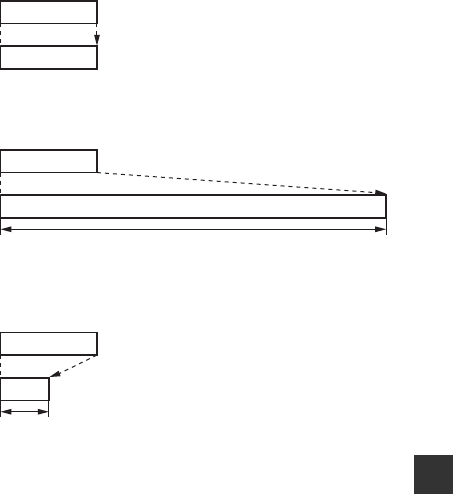
99
Using Menus
CPlaying Back in Slow Motion and Fast Motion
When recording at normal speed:
When recording at h HS 480/4×, or a HS 480/4×:
Movies are recorded at 4× normal speed.
They are played back in slow motion at 4× slower speed.
When recording at j HS 1080/0.5×, or Y HS 1080/0.5×:
Movies are recorded at 1/2 normal speed.
They are played back in fast motion at 2× faster speed.
Recording
time 10 s
Playback
time 10 s
Recording
time 10 s
Slow motion playback
Playback
time 40 s
Recording
time 10 s
Fast motion playback
Playback
time 5 s
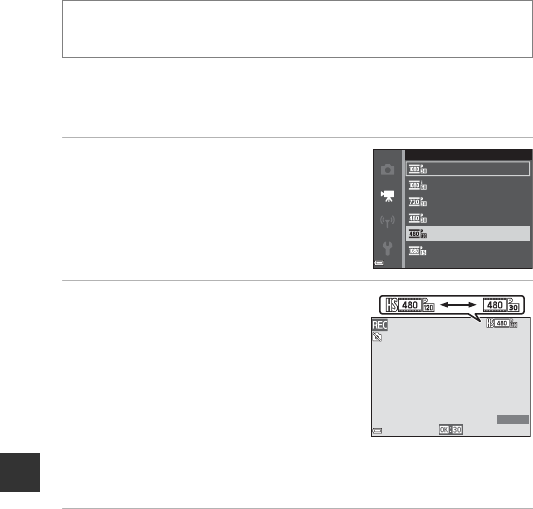
100
Using Menus
Recording Movies in Slow Motion and Fast Motion (HS
Movie)
Movies recorded using HS movie can be played back in slow motion at 1/4 of
the normal playback speed, or in fast motion at twice the normal playback
speed.
1Use the multi selector HI to
select an HS movie option (A98)
and press the k button.
•After applying the option, press the d
button to return to the shooting screen.
2Press the b(emovie-record)
button to start recording.
•The camera switches between normal
speed movie recording and HS movie
recording each time the k button is
pressed.
•The movie options icon changes when
switching between HS movie recording
and normal speed movie recording.
•When the maximum recording time for HS
movies (A98) is reached, the camera automatically switches to normal
speed movie recording.
3Press the b(e) button to end recording.
Enter shooting mode M d button M D menu icon M Movie options
M k button
HS 1080/0.5×
HS 480/4×
480/30p
720/30p
1080/60i
1080/30p
Movie options
5s
5s
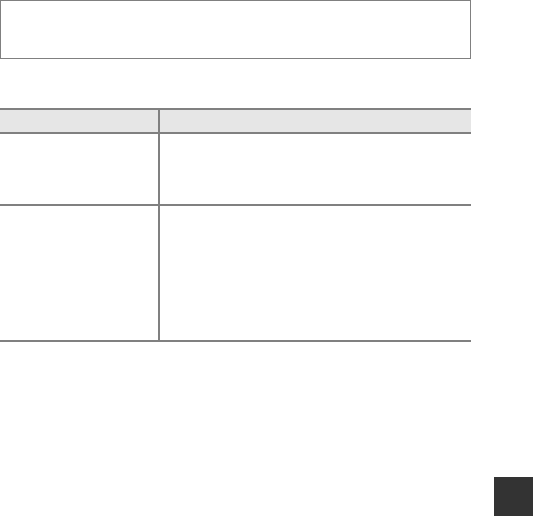
101
Using Menus
Autofocus Mode
Set how the camera focuses in short movie show mode or when recording
movies.
•When an HS movie option is selected in Movie options, the setting is fixed
at Single AF.
Enter shooting mode M d button M D menu icon M Autofocus mode
M k button
Option Description
A Single AF
(default setting)
Focus is locked when movie recording starts.
Select this option when the distance between the
camera and subject will remain fairly consistent
during movie recording.
B Full-time AF
The camera focuses continuously during movie
recording.
Select this option when the distance between the
camera and subject will change significantly during
recording. The sound of the camera focusing may be
heard in the recorded movie. Use of Single AF is
recommended to prevent the sound of the camera
focusing from interfering with recording.
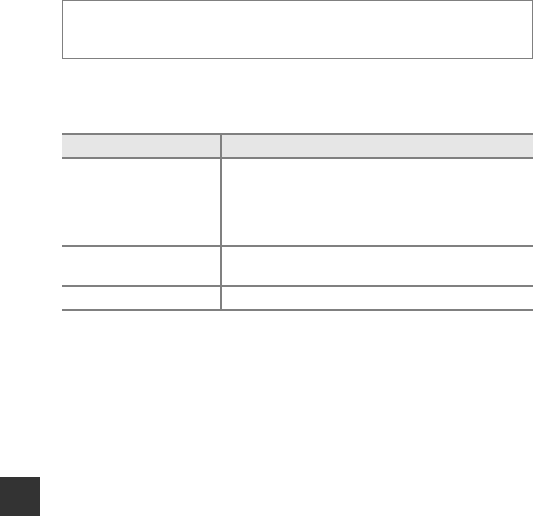
102
Using Menus
Movie VR
Select the vibration reduction setting used in short movie show mode or when
recording movies.
Select Off when using a tripod to stabilize the camera during shooting.
•When an HS movie option is selected in Movie options, the setting is fixed
at Off.
BNotes About Movie VR
•The effects of camera shake may not be completely eliminated in some situations.
•In special effects mode, only lens shift VR is used to compensate for camera shake
when Movie options is set to Z 1080/60i or U 1080/50i, even if Movie
VR is set to On (hybrid).
Enter shooting mode M d button M D menu icon M Movie VR M
kbutton
Option Description
V On (hybrid)
(default setting)
Performs optical compensation for camera shake
using lens shift VR and simultaneously performs
electronic VR using image processing. The angle of
view (i.e., the area visible in the frame) becomes
narrower.
g On Performs compensation for camera shake using lens
shift VR.
Off Compensation is not performed.
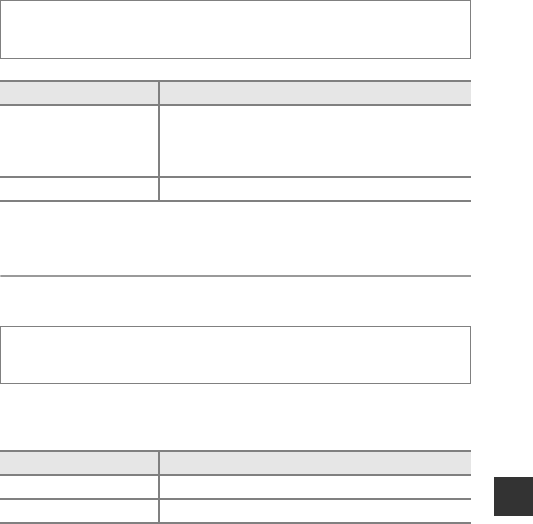
103
Using Menus
Wind Noise Reduction
•When an HS movie option is selected in Movie options, the setting is fixed
at Off.
Frame Rate
Select the frame rate (fields per second for the interlaced format) used in short
movie show mode or when recording movies. When the frame rate setting is
switched, options that can be set in Movie options (A97) change.
Enter shooting mode M d button M D menu icon M Wind noise
reduction M kbutton
Option Description
Y On
Reduces the sound that is produced when wind
passes over the microphone during movie recording.
Other sounds may become difficult to hear during
playback.
Off (default setting) Wind noise reduction is disabled.
Enter shooting mode M d button M D menu icon M Frame rate M
kbutton
Option Description
30 fps (30p/60i) Suited for playback on a TV using the NTSC standard.
25 fps (25p/50i) Suited for playback on a TV using the PAL standard.

104
Using Menus
Configure the Wi-Fi (wireless LAN) settings to connect the camera and a smart
device.
The Wi-Fi Options Menu
Press the d button M J menu icon M k button
Option Description
Connect to
smart
device
Select when wirelessly connecting the camera and a smart device.
See “Connecting the Smart Device to the Camera” (A118) for
more information.
Upload
from
camera
Select when wirelessly connecting the camera and a smart device.
See “Preselecting Images in the Camera That You Want to Transfer
to a Smart Device” (A120) for more information.
•The images to transfer can be selected on the image selection
screen before establishing a Wi-Fi connection (A91, 96). The
SSID and password of the camera are displayed on the screen
after images are selected.
Disable
Wi-Fi
Select to terminate the wireless connection between the camera
and a smart device. See “To Terminate the Wi-Fi Connection”
(A119) for more information.
Options
SSID: Change the SSID. The SSID configured here is displayed on
the smart device. Set a 1- to 24-character alphanumeric SSID.
Auth./encryp.: Select whether or not to encrypt the
communications between the camera and the connected smart
device.
Communications are not encrypted when Open (default setting) is
selected.
•When WPA2-PSK-AES is set, the message for entering a
password is displayed when the camera is connected to smart
device (A118).
Password: Set the password. Set an 8- to 16-character
alphanumeric password.
Channel: Select the channel used for wireless connections.
Current
settings Display the current settings.
Restore
default
settings
Restore the Wi-Fi settings to their default values. The wireless
connection is terminated if this option is performed while Wi-Fi is
connected.
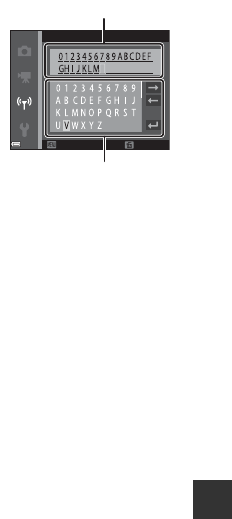
105
Using Menus
Operating the Text Input Keyboard
•Use the multi selector HIJK to select
alphanumeric characters. Press the k button
to enter the selected character in the text
field and move the cursor to the next space.
•To move the cursor in the text field, select N
or O on the keyboard, and press the k
button.
•To delete one character, press the l button.
•To apply the setting, select P on the
keyboard and press the k button.
Delete
Back
SSID
Text field
Keyboard
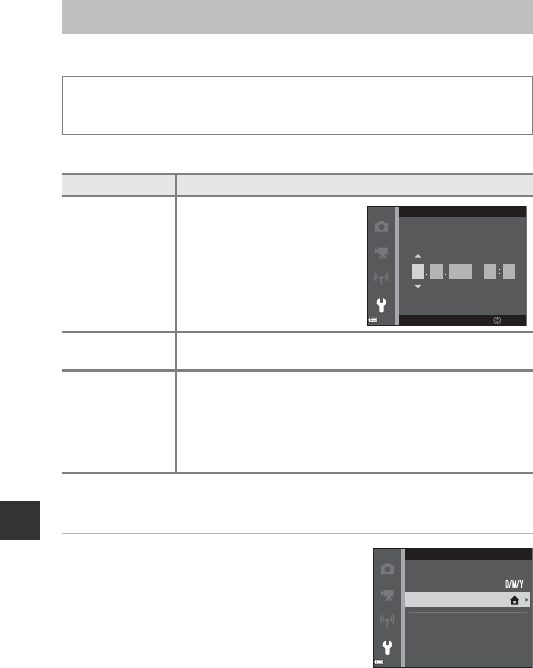
106
Using Menus
Time Zone and Date
Set the camera clock.
Setting the Time Zone
1Use the multi selector HI to
select Time zone and press the k
button.
The Setup Menu
Press the d button M z menu icon M Time zone and date M k
button
Option Description
Date and time
•Select a field: Press the
multi selector JK.
•Edit the date and time:
Press HI.
•Apply the setting: Select
the minute field setting
and press the k button.
Date format Select Year/Month/Day, Month/Day/Year, or Day/Month/
Year.
Time zone
Set time zone and daylight saving time.
•When Travel destination (x) is set after having set the
home time zone (w), the time difference between the
travel destination and the home time zone is automatically
calculated, and the date and time are saved for the selected
region.
11
15 15 30
Edit
mhD M
2015
Y
Date and time
15/11/2015 15:30
Time zone
Date format
Date and time
Time zone and date
London, Casablanca
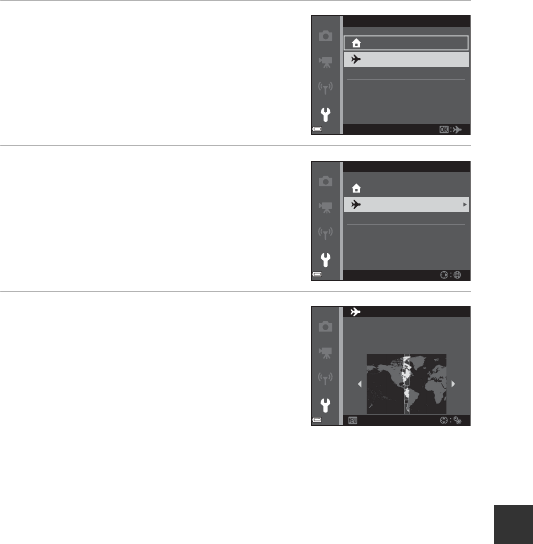
107
Using Menus
2Select w Home time zone or x
Travel destination and press the
k button.
•The date and time displayed in the monitor
changes depending on whether the home
time zone or travel destination is selected.
3Press K.
4Use JK to select the time zone.
•Press H to enable daylight saving time
function, and W is displayed. Press I to
disable the daylight saving time function.
•Press the k button to apply the time zone.
•If the correct time is not displayed for the
home or travel destination time zone
setting, set the appropriate time in Date
and time.
Travel destination
Home time zone
Time zone
London, Casablanca
15/11/2015 15:30
Travel destination
Home time zone
Time zone
London, Casablanca
15/11/2015 15:30
New York, Toronto, Lima
10:30 –5:00
Back
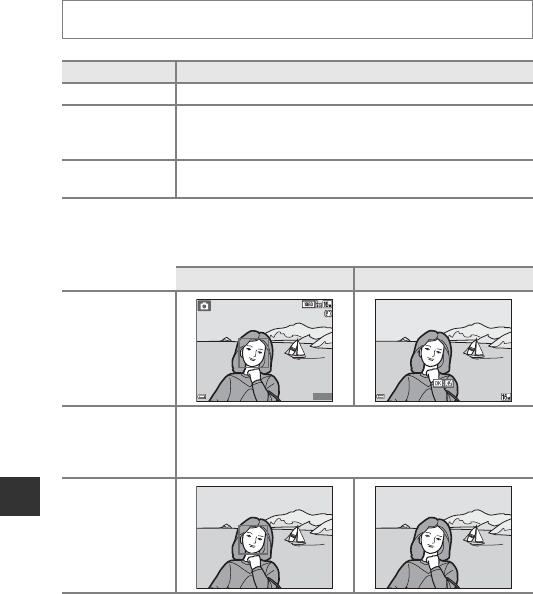
108
Using Menus
Monitor Settings
Photo Info
Press the d button M z menu icon M Monitor settings M k button
Option Description
Photo info Set whether or not to display information in the monitor.
Image review
Set whether or not to display the captured image immediately
after shooting.
•Default setting: On
Brightness Adjust the brightness.
•Default setting: 3
Shooting mode Playback mode
Show info
Auto info
(default setting)
The same information as shown in Show info is displayed,
and it is hidden as shown in Hide info if no operations are
performed for a few seconds. The information is displayed
again when an operation is performed.
Hide info
25
m
0s
25
m
0s
880
880
4
/
4
4
/
4
15/11/2015 15:30
15/11/2015 15:30
0004.
JPG
0004.
JPG
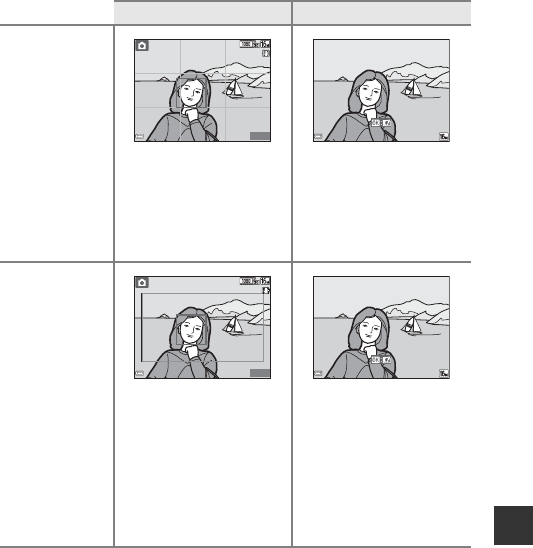
109
Using Menus
Framing
grid+auto info In addition to the information
shown in Auto info, a
framing grid is displayed to
help frame pictures.
The framing grid is not
displayed while recording
movies.
Same as Auto info.
Movie
frame+auto info
In addition to the information
shown in Auto info, a frame
is displayed before movie
recording begins that
represents the area that will
be captured when recording
movies.
The movie frame is not
displayed while recording
movies.
Same as Auto info.
Shooting mode Playback mode
25
m
0s
25
m
0s
880
880
4
/
4
4
/
4
15/11/2015 15:30
15/11/2015 15:30
0004.
JPG
0004.
JPG
25
m
0s
25
m
0s
880
880
4
/
4
4
/
4
15/11/2015 15:30
15/11/2015 15:30
0004.
JPG
0004.
JPG
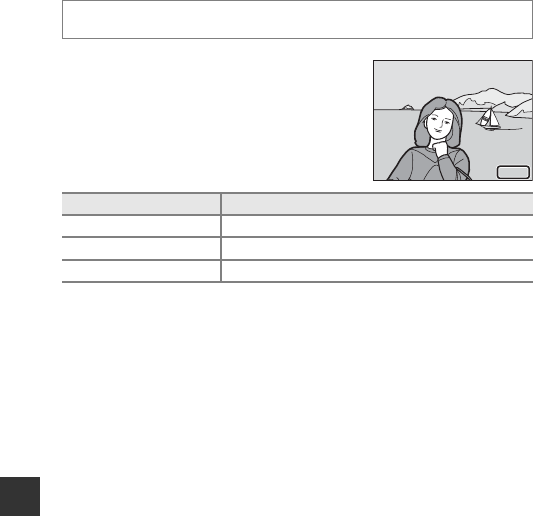
110
Using Menus
Date Stamp
The shooting date and time can be stamped on
images when shooting.
BNotes About Date Stamp
•Stamped dates form a permanent part of image data and cannot be deleted. The
date and time cannot be stamped on images after they have been captured.
•The date and time cannot be stamped in the following situations:
- When using Night portrait (when Hand-held is selected), Night landscape
(when Hand-held is selected), Backlighting (when HDR is set), or Easy
panorama scene mode
- When the continuous shooting setting (A82) is set to Pre-shooting cache,
Continuous H: 120 fps, or Continuous H: 60 fps
- When shooting movies
- When saving still images during moving recording
•The stamped date and time may be difficult to read when using a small image size.
CPrinting a Shooting Date on Images Without a Date Stamp
You can transfer images to a computer and use the ViewNX 2 software (A128) to
imprint the shooting date on the images when they are printed.
Press the d button M z menu icon M Date stamp M k button
Option Description
fDate Date is stamped on images.
SDate and time Date and time are stamped on images.
Off (default setting) Date and time are not stamped on images.
15.11.2015
15.11.2015
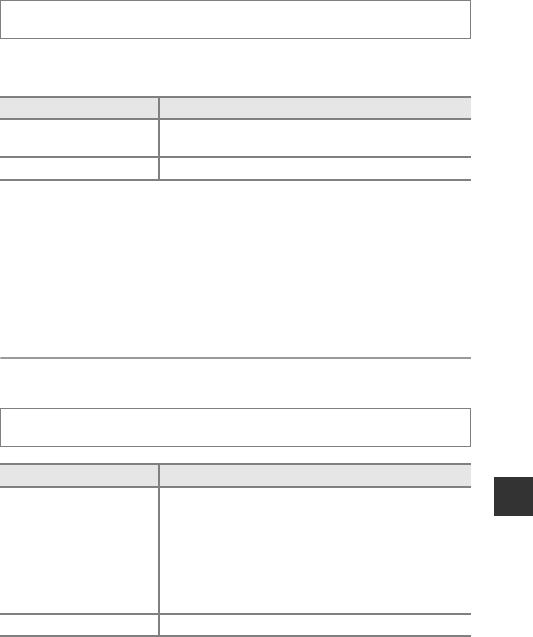
111
Using Menus
Photo VR
Select the vibration reduction setting used when shooting still images.
Select Off when using a tripod to stabilize the camera during shooting.
BNotes About Photo VR
•After turning on the camera or after switching from playback mode to shooting
mode, wait for the shooting mode screen to be displayed completely before
taking pictures.
•Images in the camera monitor may be displayed blurry immediately after shooting.
•The effects of camera shake may not be completely eliminated in some situations.
AF Assist
Press the d button M z menu icon M Photo VR M k button
Option Description
gOn (default setting) Compensation for camera shake is performed using
lens shift VR.
Off Compensation is not performed.
Press the d button M z menu icon M AF assist M k button
Option Description
a Auto
(default setting)
The AF-assist illuminator automatically lights up when
you press the shutter-release button under dim
lighting. The illuminator has a range of about 2.0 m (6
ft 6 in.) at the maximum wide-angle position and
about 2.0 m (6 ft 6 in.) at the maximum telephoto
position.
•Note that for some shooting modes or focus areas,
the AF-assist illuminator may not light.
Off The AF-assist illuminator does not light.

112
Using Menus
Digital Zoom
BNotes About Digital Zoom
•Digital zoom cannot be used in the following shooting modes:
-Portrait, Night portrait, Night landscape, Backlighting (when HDR is set),
Easy panorama, or Pet portrait scene mode
- Smart portrait mode
•Digital zoom cannot be used in other shooting modes when using certain settings
(A57).
Sound Settings
Press the d button M z menu icon M Digital zoom M k button
Option Description
On (default setting) Digital zoom is enabled.
Off Digital zoom is disabled.
Press the d button M z menu icon M Sound settings M k button
Option Description
Button sound
When On (default setting) is selected, the camera
produces one beep when operations are performed,
two beeps when focus is acquired on the subject, and
three beeps when an error occurs. The welcome
screen sound is also produced.
•Sounds are disabled when using Pet portrait
scene mode.
Shutter sound
When On (default setting) is selected, the shutter
sound is produced when the shutter is released.
•The shutter sound is not produced when using
continuous shooting mode, when recording
movies, or when using Pet portrait scene mode.

113
Using Menus
Auto Off
Set the amount of time that elapses before the camera enters standby mode
(A14).
You can select 30 s, 1 min (default setting), 5 min, or 30 min.
CSetting the Auto Off Function
The time that passes before the camera enters standby mode is fixed in the following
situations:
•When a menu is displayed: 3 minutes (when auto off is set to 30 s or 1 min)
•When shooting using Pet portrait auto release: 5 minutes (when auto off is set
to 30 s or 1 min)
•When shooting using Smile timer: 5 minutes (when auto off is set to 30 s or
1 min)
•When the AC Adapter is connected: 30 minutes
•When an HDMI cable is connected: 30 minutes
Press the d button M z menu icon M Auto off M k button

114
Using Menus
Format Card/Format Memory
Use this option to format a memory card or the internal memory.
Formatting the memory cards or internal memory permanently deletes
all data. Data that has been deleted cannot be recovered. Make sure to
save important images to a computer before formatting.
Formatting a Memory Card
•Insert a memory card into the camera.
•Select Format card in the setup menu and then press the k button.
Formatting the Internal Memory
•Remove the memory card from the camera.
•Select Format memory in the setup menu and then press the k button.
To start formatting, select Format on the screen that is displayed and press the
k button.
•Do not turn the camera off or open the battery-chamber/memory card slot
cover during formatting.
Language
Select a language for display of camera menus and messages.
Press the d button M z menu icon M Format card/Format memory M
k button
Press the d button M z menu icon M Language M k button
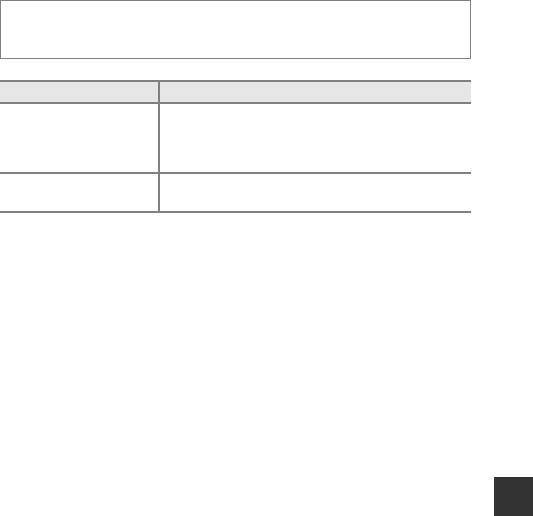
115
Using Menus
Charge by Computer
BNotes About Charging with a Computer
•When connected to a computer, the camera turns on and starts charging. If the
camera is turned off, charging stops.
•About 3 hours are required to charge a fully exhausted battery. Charging time
increases when images are transferred while the battery is charging.
•The camera turns off automatically if there is no communication with the
computer for 30 minutes after the battery has finished charging.
BWhen the Charge Lamp Quickly Flashes Green
Charging cannot be performed, possibly due to one of the reasons described below.
•The ambient temperature is not suited to charging. Charge the battery indoors
with an ambient temperature of 5°C to 35°C (41°F to 95°F).
•The USB cable is not connected correctly, or the battery is faulty. Make sure the USB
cable is connected correctly or replace the battery if necessary.
•The computer is in sleep mode and is not supplying power. Wake up the
computer.
•The battery cannot be charged because the computer cannot supply power to the
camera due to the computer’s settings or its specifications.
Press the d button M z menu icon M Charge by computer M k
button
Option Description
a Auto
(default setting)
When the camera is connected to a computer that is
running (A121), the battery inserted into the camera
is automatically charged using power supplied by the
computer.
Off The battery inserted into the camera is not charged
when the camera is connected to a computer.

116
Using Menus
Reset All
When Reset is selected, the camera’s settings are restored to their default
values.
•Some settings, such as Time zone and date or Language, are not reset.
•The wireless connection is terminated if this option is performed while Wi-Fi
is connected.
CResetting File Numbering
To reset file numbering to “0001”, delete all images saved on the memory card or in
the internal memory (A17) before selecting Reset all.
Conformity Marking
View some of the conformity markings that the camera complies with.
Firmware Version
View the current camera firmware version.
•The firmware version cannot be displayed while Wi-Fi is connected.
Press the d button M z menu icon M Reset all M k button
Press the d button M z menu icon M Conformity marking M k
button
Press the d button M z menu icon M Firmware version M k button

117
Using the Wi-Fi (Wireless LAN) Function
Using the Wi-Fi (Wireless LAN)
Function
You can perform the following functions if you install the dedicated software
“Wireless Mobile Utility” on your smart device that runs on Android OS or iOS,
and connect it to the camera.
Take Photos
You can capture still images using the two methods described below.
•Release the shutter on the camera and save the captured images to a smart
device.
•Use a smart device to remotely release the camera shutter and save images
to the smart device.
View Photos
Images that are saved in the camera’s memory card can be transferred and
viewed on your smart device. You can also preselect the images in the camera
that you want to transfer to your smart device.
BNotes About Security Settings
No security settings such as password are configured for the camera at the time of
purchase. We strongly recommend performing the required security settings before
using the Wi-Fi function. Use Options in the Wi-Fi options menu (A76) to perform
the security settings.
1Use your smart device to connect to the Google Play Store,
App Store or other online apps marketplace and search for
“Wireless Mobile Utility.”
•Check the user’s manual provided with your smart device for further details.
2Check the description and other information and install the
software.
CUser’s Manual for Wireless Mobile Utility
Download the user’s manual from the website below.
•Android OS: http://nikonimglib.com/ManDL/WMAU/
•iOS: http://nikonimglib.com/ManDL/WMAU-ios/
Installing the Software on the Smart Device
To establish a connection with the camera, press the Z (Wi-Fi) button on the camera,
and turn on the Wi-Fi function of the smart device, and then start the “Wireless Mobile
Utility” while Negotiating... Please wait. is displayed on the camera.
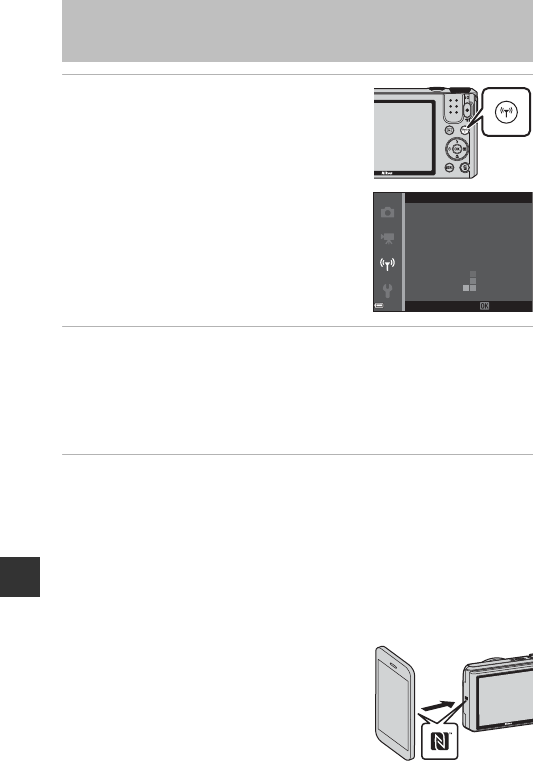
118
Using the Wi-Fi (Wireless LAN) Function
1Press the Z (Wi-Fi) button on the
camera.
•The screen shown on the right is displayed.
•If no connection confirmation is received
from the smart device within three minutes,
the message No access. is displayed and
the camera returns to the Wi-Fi options
screen.
•You can also select Connect to smart
device in the Wi-Fi options menu to
display the screen shown on the right.
2Set the Wi-Fi setting on the smart device to On.
•Check the user’s manual provided with your smart device for further details.
•After the network names (SSIDs) that can be used for the smart device are
displayed, select the SSID displayed on the camera.
•When Auth./encryp. is set to WPA2-PSK-AES in the Wi-Fi options menu,
the message for entering a password is displayed.
Enter the password that is displayed on the camera.
3Start the “Wireless Mobile Utility” installed on the smart
device, while Negotiating... Please wait. is displayed on
the camera.
•The screen for selecting “Take photos” or “View photos” is displayed.
•When the message “Cannot connect to camera.” is displayed, return to
step 1 and retry the procedure.
•See “Installing the Software on the Smart Device” (A117).
CTouching an NFC-compatible Smart Device to the Camera for a
Wi-Fi Connection
When you use a smart device that is compatible
with near field communication (NFC) functions and
runs on Android OS, you can establish a Wi-Fi
connection and start the “Wireless Mobile Utility” by
touching the NFC antenna on the smart device to
the Y (N-Mark) on the camera.
Connecting the Smart Device to the
Camera
XXXXXXXXXXXXXXXXXX
XXXXXX
XXXXXXXXXXXXXXXX
Cancel
Password:
SSID:
Connect to smart device

119
Using the Wi-Fi (Wireless LAN) Function
To Terminate the Wi-Fi Connection
Perform one of the operations described below.
•Turn off the camera.
•Select Disable Wi-Fi in the Wi-Fi options menu on the camera (except
when the camera is operated by remote control).
•Set the Wi-Fi setting on the smart device to Off.
BNotes About Wi-Fi Connection
•Wi-Fi connection operations are disabled in the following situations:
- When the camera is connected to a TV, computer, or printer
- While recording movies
- While the camera is processing data such as saving images or recording movies
- When the camera is connected to a smart device
•Select Disable Wi-Fi in areas where the use of radio waves is prohibited.
•When Wi-Fi is connected, Auto off is disabled.
•When Wi-Fi is connected, the battery drains faster than normal.
•The Wi-Fi connection is terminated in the following situations:
- When the battery level is low
- When starting movie recording in short movie show mode
CSecurity Settings
If no security settings (encryption and password) are configured for the camera’s
Wi-Fi function, unauthorized third parties may access the network and cause harm.
We strongly recommend performing the required security settings before using the
Wi-Fi function.
Use Options in the Wi-Fi options menu (A104) to perform the security settings.

120
Using the Wi-Fi (Wireless LAN) Function
You can preselect images in the camera that you want to transfer to a smart
device. Movies cannot be preselected for transfer.
1Select images to transfer.
You can preselect the images to transfer to a smart device in the following
menus:
•Mark for Wi-Fi upload in the playback menu (A91)
•Upload from camera in the Wi-Fi options menu (A104)
When using Upload from camera, the SSID and password of the camera are
displayed after images are selected.
2Connect the camera and smart device (A118).
•Tapping “View photos” in the “Wireless Mobile Utility” displays the
confirmation screen to transfer the specified images to the smart device.
BPreselecting Images to Transfer During Playback
While the camera is in playback mode, press the Z button or use the NFC function
to establish a Wi-Fi connection, and preselect the displayed images that you want to
transfer.
•You can preselect one image in full-frame playback mode. You can preselect all
images in the sequence when the key picture is displayed for images in a
sequence.
•You can preselect one image specified in thumbnail playback mode. You can
preselect all images in the sequence when the key picture is displayed for images
in a sequence.
•You can preselect all the images captured on the selected date in calendar display
playback mode.
This operation is not available when you use Connect to smart device in the Wi-Fi
options menu to establish the Wi-Fi connection.
Preselecting Images in the Camera That
You Want to Transfer to a Smart Device
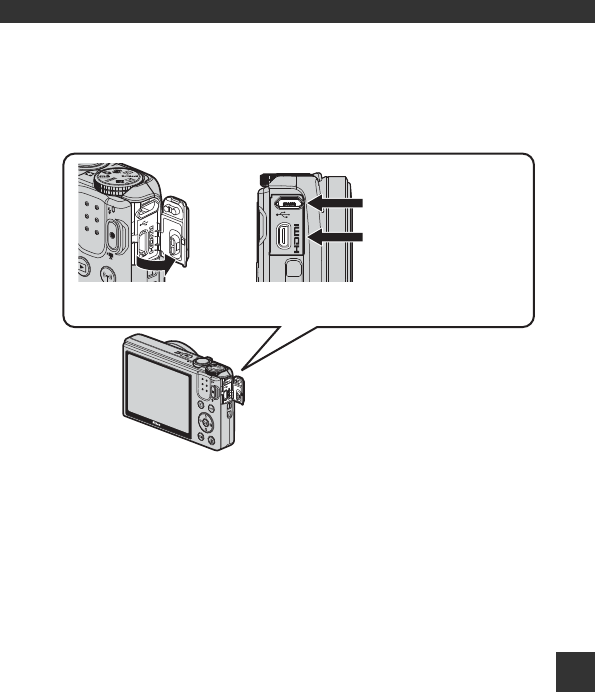
121
Connecting the Camera to a TV, Printer, or Computer
Connecting the Camera to a TV,
Printer, or Computer
You can enhance your enjoyment of images and movies by connecting the
camera to a TV, printer, or computer.
•Before connecting the camera to an external device, make sure the
remaining battery level is sufficient and turn the camera off. Before
disconnecting, make sure to turn the camera off.
•If the AC Adapter EH-62G (available separately) is used, this camera can be
powered from an electrical outlet. Do not use any other make or model of
AC adapter as it may cause the camera to heat up or malfunction.
•For information about the connection methods and subsequent operations,
refer to the documentation included with the device in addition to this
document.
Insert the plug straight.
Micro-USB connector
HDMI micro connector
(Type D)
Open the connector
cover.
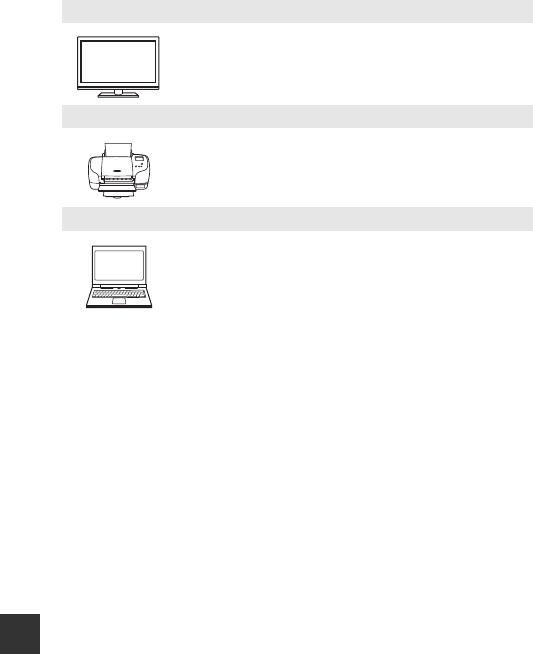
122
Connecting the Camera to a TV, Printer, or Computer
Viewing images on a TV A123
Images and movies captured with the camera can be viewed
on a TV.
Connection method: Connect a commercially available HDMI
cable to the TV’s HDMI input jack.
Printing images without using a computer A124
If you connect the camera to a PictBridge-compatible printer,
you can print images without using a computer.
Connection method: Connect the camera directly to the
printer’s USB port with the USB cable.
Viewing and organizing images on a computer A128
You can transfer images to a computer to perform simple
retouching and manage image data.
Connection method: Connect the camera to the computer’s
USB port with the USB cable.
•Before connecting to a computer, install ViewNX 2 on the
computer (A128).
•If any USB devices that draw the power from the computer
are connected, disconnect them from the computer before
you connect the camera to it. Connecting the camera and
other USB-powered devices to the same computer
simultaneously may cause a camera malfunction or
excessive power supply from the computer, which could
damage the camera or memory card.
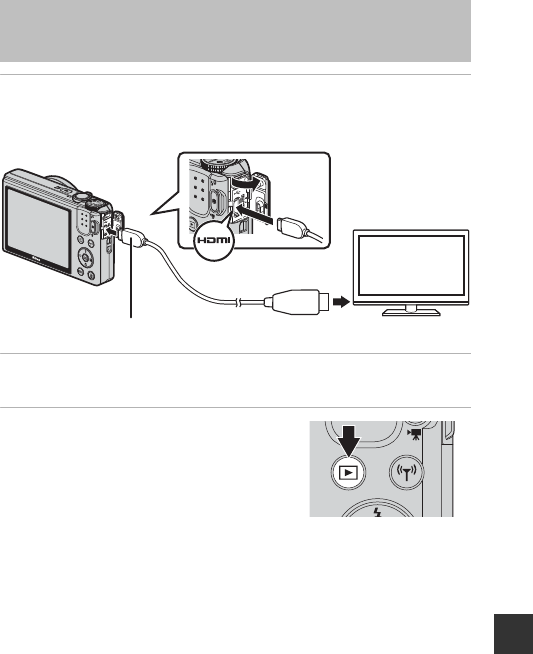
123
Connecting the Camera to a TV, Printer, or Computer
1Turn off the camera and connect it to the TV.
•Make sure that the plugs are properly oriented. Do not insert or remove the
plugs at an angle when connecting or disconnecting them.
2Set the TV’s input to external input.
•See the documentation provided with your TV for details.
3Hold down the c (playback)
button to turn on the camera.
•Images are displayed on the TV.
•The camera monitor does not turn on.
Connecting the Camera to a TV (Playback
on a TV)
HDMI micro connector (Type D) to HDMI jack
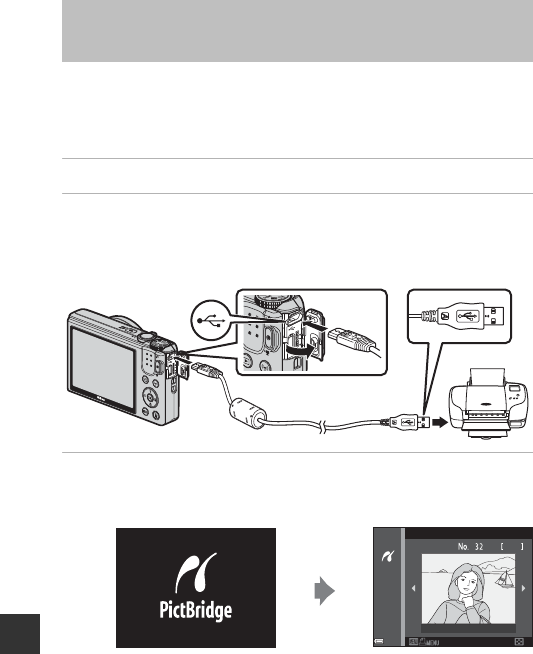
124
Connecting the Camera to a TV, Printer, or Computer
Users of PictBridge-compatible printers can connect the camera directly to the
printer and print images without using a computer.
Connecting the Camera to a Printer
1Turn on the printer.
2Turn off the camera and connect it to the printer using the
USB cable.
•Make sure that the plugs are properly oriented. Do not insert or remove the
plugs at an angle when connecting or disconnecting them.
3The camera is automatically turned on.
•The PictBridge startup screen (1) is displayed in the camera monitor,
followed by the Print selection screen (2).
Connecting the Camera to a Printer (Direct
Print)
32
15/11/2015
Print selection
12
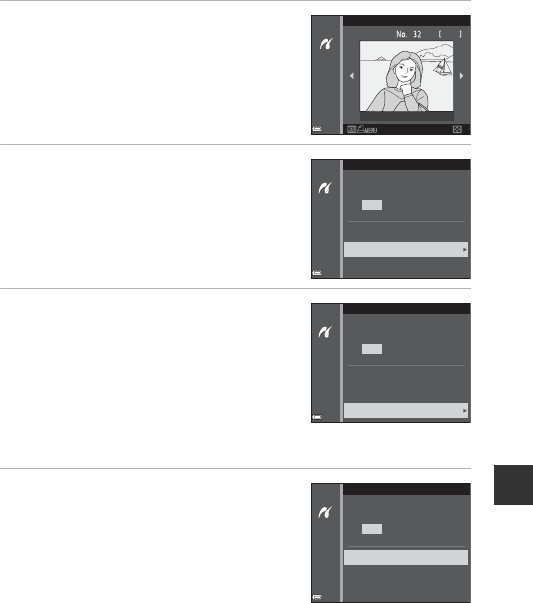
125
Connecting the Camera to a TV, Printer, or Computer
BIf the PictBridge Startup Screen Is Not Displayed
When Auto is selected for Charge by computer (A115), it may be impossible to
print images with direct connection of the camera to some printers. If the PictBridge
startup screen is not displayed after the camera is turned on, turn the camera off and
disconnect the USB cable. Set Charge by computer to Off and reconnect the
camera to the printer.
Printing Images One at a Time
1Use the multi selector JK to
select the desired image and press
the k button.
•Move the zoom control toward f(h) to
switch to thumbnail playback or g(i) to
switch to full-frame playback.
2Use HI to select Copies and
press the k button.
•Use HI to set the desired number of
copies (up to 9) and press the k button.
3Select Paper size and press the k
button.
•Select the desired paper size and press the
k button.
•To print with the paper size setting
configured on the printer, select Default.
•The paper size options available on the
camera vary depending on the printer that
you use.
4Select Start print and press the k
button.
•Printing starts.
32
15/11/2015
Print selection
Paper size
Copies
Start print
1 prints
PictBridge
Paper size
Copies
Start print
PictBridge
4 prints
Paper size
Copies
Start print
PictBridge
4 prints
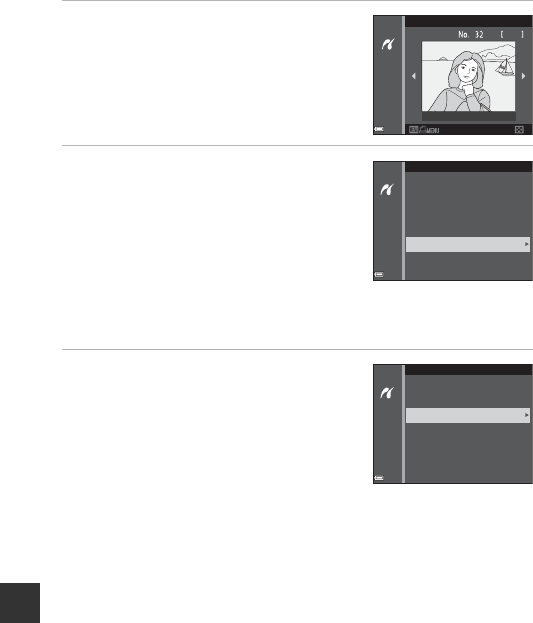
126
Connecting the Camera to a TV, Printer, or Computer
Printing Multiple Images
1When the Print selection screen
is displayed, press the d (menu)
button.
2Use the multi selector HI to
select Paper size and press the k
button.
•Select the desired paper size and press the
k button.
•To print with the paper size setting
configured on the printer, select Default.
•The paper size options available on the
camera vary depending on the printer that you use.
•To exit the print menu, press the d button.
3Select Print selection, or Print all
images, and press the k button.
32
15/11/2015
Print selection
Paper size
Print all images
Print selection
Print menu
Paper size
Print all images
Print selection
Print menu

127
Connecting the Camera to a TV, Printer, or Computer
Print selection
Select images (up to 99) and the number
of copies (up to 9) of each.
•Use the multi selector JK to select
images, and use HI to specify the
number of copies to be printed.
•Images selected for printing are
indicated by M and the number of
copies to be printed. To cancel the print
selection, set the number of copies to 0.
•Move the zoom control toward g(i) to switch to full-frame playback or
f(h) to switch to thumbnail playback.
•Press the k button when setting is complete. When the screen for
confirming the number of print copies is displayed, select Start print
and press the k button to start printing.
Print all images
One copy each of all images saved in the internal memory, or on the
memory card, is printed.
•When the screen for confirming the number of print copies is displayed,
select Start print and press the k button to start printing.
Back
Print selection
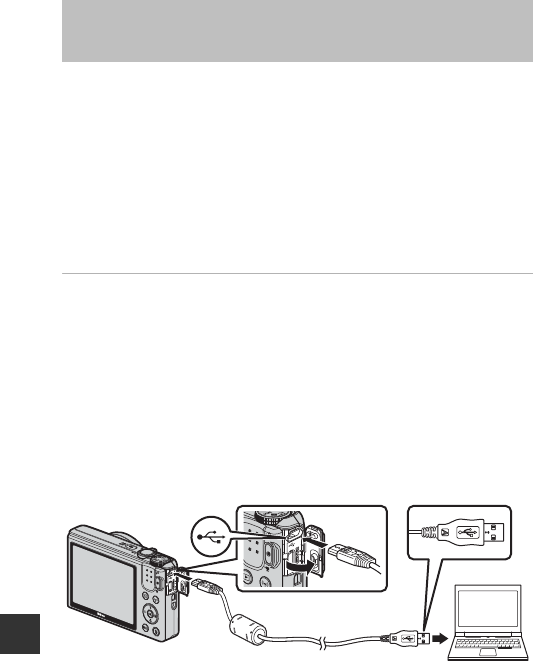
128
Connecting the Camera to a TV, Printer, or Computer
Installing ViewNX 2
ViewNX 2 is free software that enables you to transfer images and movies to
your computer so that you can view, edit, or share them. To install ViewNX 2,
download the ViewNX 2 installer from the website below and follow the on-
screen installation instructions.
http://nikonimglib.com/nvnx/
For system requirements and other information, see the Nikon website for your
region.
Transferring Images to a Computer
1Prepare a memory card that contains images.
You can use any of the methods below to transfer images from the memory
card to a computer.
•SD memory card slot/card reader: Insert the memory card into the card
slot of your computer or the card reader (commercially available) that is
connected to the computer.
•Direct USB connection: Turn the camera off and ensure that the memory
card is inserted in the camera. Connect the camera to the computer using
the USB cable.
The camera automatically turns on.
To transfer images that are saved in the camera’s internal memory, remove
the memory card from the camera before connecting it to the computer.
Using ViewNX 2 (Transferring Images to a
Computer)
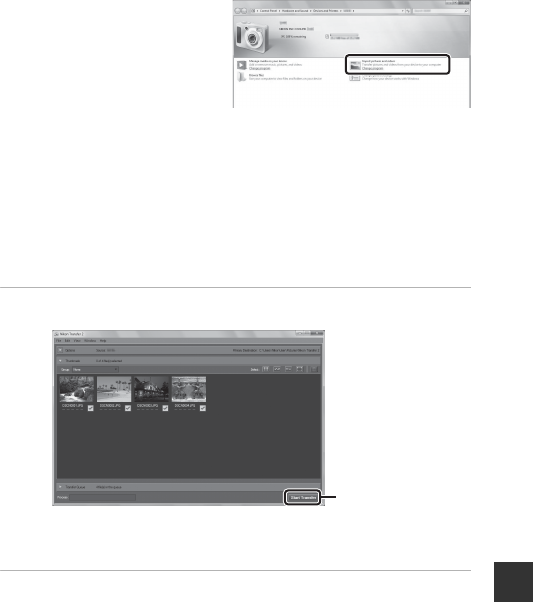
129
Connecting the Camera to a TV, Printer, or Computer
If a message is displayed prompting you to choose a program, select
Nikon Transfer 2.
•When using Windows 7
If the dialog shown at right is
displayed, follow the steps
below to select Nikon Transfer 2.
1Under Import pictures
and videos, click Change
program. A program
selection dialog will be
displayed; select Import
File using Nikon Transfer 2 and click OK.
2Double-click Import File.
If the memory card contains a large number of images, it may take a while for
Nikon Transfer 2 to start. Wait until Nikon Transfer 2 starts.
BNotes About Connecting the USB Cable
Operation is not guaranteed if the camera is connected to the computer via a USB
hub.
2After Nikon Transfer 2 starts, click Start Transfer.
•Image transfer begins. When image transfer is complete, ViewNX 2 starts and
the transferred images are displayed.
•Consult online help for more information on using ViewNX 2.
3Terminate the connection.
•If you are using a card reader or card slot, choose the appropriate option in
the computer operating system to eject the removable disk corresponding
to the memory card and then remove the memory card from the card reader
or card slot.
•If the camera is connected to the computer, turn the camera off and
disconnect the USB cable.
Start Transfer

130
Technical Notes
Technical Notes
Caring for the Product .................................................................................131
The Camera..............................................................................................131
The Battery...............................................................................................132
The Charging AC Adapter ..................................................................133
Memory Cards.........................................................................................134
Cleaning and Storage ..................................................................................135
Cleaning....................................................................................................135
Storage ......................................................................................................135
Error Messages ...............................................................................................136
Troubleshooting ............................................................................................140
File Names........................................................................................................147
Optional Accessories....................................................................................148
Specifications..................................................................................................149
Approved Memory Cards ...................................................................153
Index...................................................................................................................155

Technical Notes
131
Observe the precautions described below in addition to the warnings in “For
Your Safety” (Avi–viii) when using or storing the device.
The Camera
Do Not Apply Strong Impact to the Camera
The product may malfunction if subjected to strong shock or vibration. In addition,
do not touch or apply force to the lens or lens cover.
Keep Dry
The device will be damaged if immersed in water or subjected to high humidity.
Avoid Sudden Changes in Temperature
Sudden changes in temperature, such as when entering or leaving a heated building
on a cold day, can cause condensation to form inside the device. To prevent
condensation, place the device in a carrying case or a plastic bag before exposing it
to sudden changes in temperature.
Keep Away from Strong Magnetic Fields
Do not use or store this device in the vicinity of equipment that generates strong
electromagnetic radiation or magnetic fields. Doing so could result in loss of data or
camera malfunction.
Do Not Point the Lens at Strong Light Sources for Extended Periods
Avoid pointing the lens at the sun or other strong light sources for extended periods
when using or storing the camera. Intense light may cause the image sensor to
deteriorate or produce a white blur effect in photographs.
Turn the Product Off Before Removing or Disconnecting the Power
Source or Memory Card
Do not remove the battery while the product is on, or while images are being saved
or deleted. Forcibly cutting power in these circumstances could result in loss of data
or in damage to product memory or internal circuitry.
Caring for the Product

Technical Notes
132
Notes About the Monitor
•Monitors and electronic viewfinders are constructed with extremely high precision;
at least 99.99% of pixels are effective, with no more than 0.01% being missing or
defective. Hence while these displays may contain pixels that are always lit (white,
red, blue, or green) or always off (black), this is not a malfunction and has no effect
on images recorded with the device.
•Images in the monitor may be difficult to see under bright lighting.
•Do not apply pressure to the monitor, as this could cause damage or malfunction.
Should the monitor break, care should be taken to avoid injury caused by broken
glass and to prevent the liquid crystal from the display touching the skin or
entering the eyes or mouth.
The Battery
Precautions for Use
•Note that the battery may become hot after use.
•Do not use the battery at ambient temperatures below 0°C (32°F) or above 40°C
(104°F) as this could cause damage or malfunction.
•If you notice any abnormalities such as excessive heat, smoke, or an unusual smell
coming from the battery, immediately discontinue use and consult your retailer or
Nikon-authorized service representative.
•After removing the battery from the camera or optional battery charger, put the
battery in a plastic bag, etc. in order to insulate it.
Charging the Battery
Check the battery level before using the camera and replace or charge the battery if
necessary.
•Charge the battery indoors with an ambient temperature of 5°C to 35°C (41°F to
95°F) before use.
•A high battery temperature may prevent the battery from charging properly or
completely, and may reduce battery performance. Note that the battery may
become hot after use; wait for the battery to cool before charging.
When charging the battery inserted into this camera using the Charging AC
Adapter or a computer, the battery is not charged at battery temperatures below
0°C (32°F) or above 50°C (122°F).
•Do not continue charging once the battery is fully charged as this will result in
reduced battery performance.
•The battery temperature may increase during charging. However, this is not a
malfunction.
Carrying Spare Batteries
Whenever possible, carry fully charged spare batteries when taking pictures on
important occasions.

Technical Notes
133
Using the Battery When Cold
On cold days, the capacity of batteries tends to decrease. If an exhausted battery is
used at a low temperature, the camera may not turn on. Keep spare batteries in a
warm place and exchange as necessary. Once warmed, a cold battery may recover
some of its charge.
Battery Terminals
Dirt on the battery terminals may prevent the camera from functioning. Should the
battery terminals become dirty, wipe them off with a clean, dry cloth before use.
Charging an Exhausted Battery
Turning the camera on or off while an exhausted battery is inserted in the camera
may result in reduced battery life. Charge the exhausted battery before use.
Storing the Battery
•Always remove the battery from the camera or optional battery charger when it is
not being used. Minute amounts of current are drawn from the battery while it is in
the camera, even when not in use. This may result in excessive battery drain and
complete loss of function.
•Recharge the battery at least once every six months and completely exhaust it
before returning it to storage.
•Put the battery in a plastic bag, etc. in order to insulate it and store it in a cool place.
The battery should be stored in a dry location with an ambient temperature of 15°C
to 25°C (59°F to 77°F). Do not store the battery in hot or extremely cold locations.
Battery Life
A marked drop in the time a fully charged battery retains its charge, when used at
room temperature, indicates that the battery needs to be replaced. Purchase a new
battery.
Recycling Used Batteries
Replace the battery when it no longer holds a charge. Used batteries are a valuable
resource. Please recycle used batteries in accordance with local regulations.
The Charging AC Adapter
•The Charging AC Adapter EH-71P is for use only with compatible devices. Do not
use with another make or model of device.
•Do not use any USB cable other than the UC-E21. Using a USB cable other than the
UC-E21 could result in overheating, fire or electric shock.
•Do not, under any circumstances, use another make or model of AC adapter other
than Charging AC Adapter EH-71P, and do not use a commercially available USB-
AC adapter or a battery charger for a mobile phone. Failure to observe this
precaution could result in overheating or in damage to the camera.
•The EH-71P is compatible with AC 100–240 V, 50/60 Hz electrical outlets. When
using in other countries, use a plug adapter (commercially available) as necessary.
For more information about plug adapters, consult your travel agency.

Technical Notes
134
Memory Cards
Precautions for Use
•Use only Secure Digital memory cards. See “Approved Memory Cards” (A153) for
recommended memory cards.
•Be sure to follow the precautions described in the documentation included with
the memory card.
•Do not put labels or stickers on memory cards.
Formatting
•Do not format the memory card using a computer.
•The first time you insert a memory card that has been used in another device into
this camera, be sure to format it with this camera. We recommend formatting new
memory cards with this camera before using them with this camera.
•Note that formatting a memory card permanently deletes all images and
other data on the memory card. Be sure to make copies of any images you wish
to keep before formatting the memory card.
•If the message Card is not formatted. Format card? is displayed when the
camera is turned on, the memory card must be formatted. If there is data that you
do not want to delete, select No. Copy the necessary data to a computer, etc. If you
want to format the memory card, select Yes. The confirmation dialog will be
displayed. To start formatting, press the k button.
•Do not perform the following during formatting, while data is being written to or
deleted from the memory card, or during data transfer to a computer. Failure to
observe this precaution could result in the loss of data or in damage to the camera
or memory card:
- Open the battery-chamber/memory card slot cover to remove/insert the battery
or memory card.
- Turn off the camera.
- Disconnect the AC adapter.
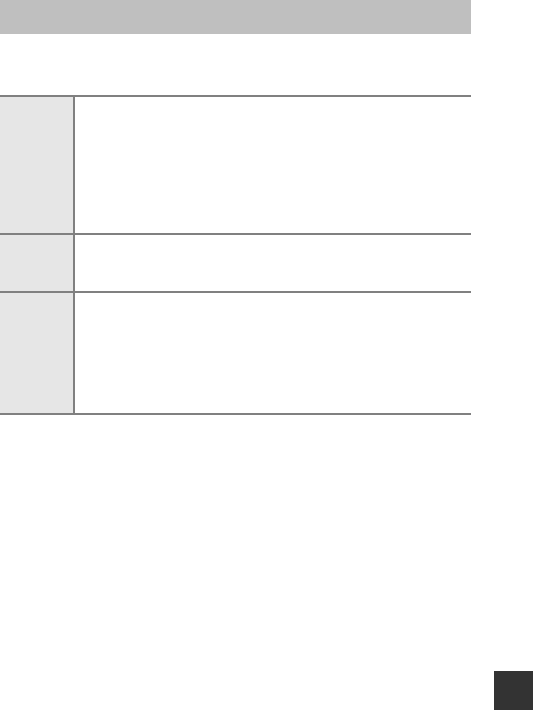
Technical Notes
135
Cleaning
Do not use alcohol, thinner, or other volatile chemicals.
Storage
Remove the battery if the camera will not be used for an extended period. To
prevent mold or mildew, take the camera out of storage at least once a month.
Turn the camera on and release the shutter a few times before putting the
camera away again. Do not store the camera in any of the following locations:
•Places that are poorly ventilated or subject to humidity of over 60%
•Exposed to temperatures above 50°C (122°F) or below –10°C (14°F)
•Next to equipment that produces strong electromagnetic fields, such as
televisions or radios
For storing the battery, follow the precautions in “The Battery” (A132) in
“Caring for the Product” (A131).
Cleaning and Storage
Lens
Avoid touching glass parts with your fingers. Remove dust or lint with
a blower (typically a small device with a rubber bulb attached to one
end that is pumped to produce a stream of air out the other end). To
remove fingerprints or other stains that cannot be removed with a
blower, wipe the lens with a soft cloth, using a spiral motion that
starts at the center of the lens and working toward the edges. If this
fails, clean the lens using a cloth lightly dampened with commercial
lens cleaner.
Monitor
Remove dust or lint with a blower. To remove fingerprints and other
stains, clean the monitor with a soft, dry cloth, being careful not to
apply pressure.
Body
•Use a blower to remove dust, dirt, or sand, then wipe gently with a
soft, dry cloth.
•After using the camera at the beach or other sandy or dusty
environment, wipe off any sand, dust, or salt with a dry cloth lightly
dampened with fresh water and dry thoroughly.
Note that foreign matter inside the camera could cause
damage not covered by the warranty.

Technical Notes
136
Refer to the table below if an error message is displayed.
Error Messages
Display Cause/Solution A
Battery temperature is
elevated. The camera will
turn off. The camera turns off automatically. Wait
until the camera or battery temperature
has cooled before resuming use.
–
The camera will turn off
to prevent overheating.
Memory card is write
protected.
The write-protect switch is in the “lock”
position. Slide the write-protect switch to
the “write” position.
–
This card cannot be used. An error occurred while accessing the
memory card.
•Use an approved memory card.
•Check that the terminals are clean.
•Confirm that the memory card is
correctly inserted.
7, 153
This card cannot be read.
Card is not formatted.
Format card?
The memory card has not been
formatted for use in the camera.
Formatting deletes all data saved on the
memory card. If you need to keep copies
of any images, make sure to select No
and save the copies to a computer or
other medium before formatting the
memory card. Select Yes and press the
k button to format the memory card.
134
Out of memory. Delete images or insert a new memory
card. 7, 17
Image cannot be saved.
An error occurred while saving the image.
Insert a new memory card or format the
memory card or internal memory.
114
The camera has run out of file numbers.
Insert a new memory card or format the
memory card or internal memory.
114
There is insufficient space to save the
copy.
Delete images from the destination.
17
Image cannot be
modified. Check that the images can be edited. 63, 145

Technical Notes
137
Cannot record movie.
A time-out error occurred while saving
the movie on the memory card.
Select a memory card with a faster write
speed.
71, 153
Save previously recorded
data as a time-lapse
movie?
The camera turned off while recording
time-lapse movie.
•Select Yes to create a time-lapse
movie with the previously captured
images.
•Select No to delete the incomplete
data.
–
Memory contains no
images.
There are no images in the internal
memory or on the memory card.
•Remove the memory card to play back
images in the internal memory.
•To copy the images saved in the
camera’s internal memory to the
memory card, press the d button to
select Copy in the playback menu.
7
94
File contains no image
data.
The file was not created or edited with
this camera.
The file cannot be viewed on this camera.
View the file using a computer or the
device used to create or edit this file.
–
This file cannot be played
back.
All images are hidden. There are no images available for a slide
show, etc. 92
This image cannot be
deleted.
The image is protected.
Disable protection. 93
No access.
The camera could not receive the signal
from the smart device. Establish the
wireless connection again.
•Press the Z button.
•Touch an NFC-compatible smart
device to the camera.
•Select Connect to smart device in
the Wi-Fi options menu.
104, 118
Could not connect.
The camera failed to establish the
connection while receiving the signals
from the smart device. Set a different
channel in Channel under Options in
the Wi-Fi options menu, and establish the
wireless connection.
104, 118
Display Cause/Solution A

Technical Notes
138
Wi-Fi connection
terminated.
The Wi-Fi connection is terminated in the
following situations:
•When the signal strength is insufficient
•When the battery level is low
•When a cable or memory card was
removed and inserted
Use a sufficiently charged battery,
disconnect the TV, computer and printer,
and then establish the wireless
connection again.
104, 118
Lens error. Try again after
turning the camera off
and on.
If the error persists, contact your retailer
or Nikon-authorized service
representative.
–
Communications error
An error occurred while communicating
with the printer.
Turn the camera off and reconnect the
USB cable.
124
System error
An error occurred in the camera’s internal
circuitry.
Turn the camera off, remove and reinsert
the battery, and turn the camera on. If the
error persists, contact your retailer or
Nikon-authorized service representative.
140
Display Cause/Solution A
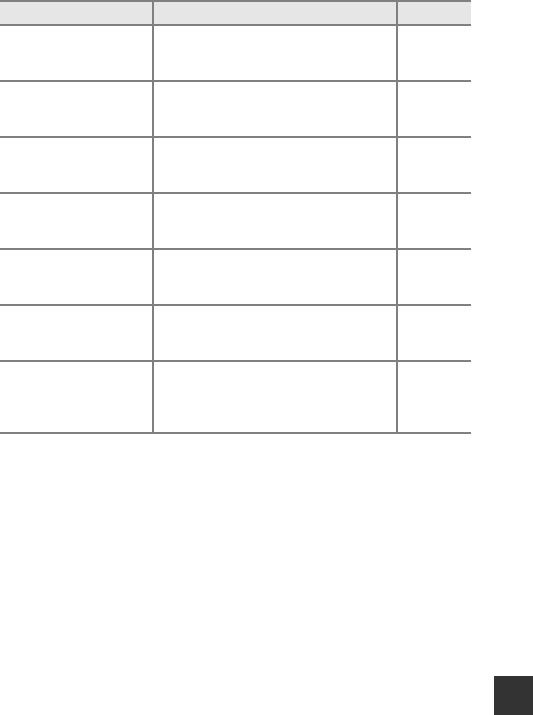
Technical Notes
139
* See the documentation provided with your printer for further guidance and
information.
Printer error: check
printer status.
After solving the problem, select Resume
and press the k button to resume
printing.*
–
Printer error: check
paper.
Load the specified size of paper, select
Resume, and press the k button to
resume printing.*
–
Printer error: paper jam.
Remove the jammed paper, select
Resume, and press the k button to
resume printing.*
–
Printer error: out of
paper.
Load the specified size of paper, select
Resume, and press the k button to
resume printing.*
–
Printer error: check ink.
There is a problem with the printer’s ink.
Check the ink, select Resume, and press
the k button to resume printing.*
–
Printer error: out of ink.
Replace the ink cartridge, select Resume,
and press the k button to resume
printing.*
–
Printer error: file corrupt.
There is a problem with the image file to
be printed.
Select Cancel and press the k button to
cancel printing.
–
Display Cause/Solution A

Technical Notes
140
If the camera fails to function as expected, check the list of common problems
below before consulting your retailer or Nikon-authorized service
representative.
Power, Display, Settings Issues
Troubleshooting
Problem Cause/Solution A
The camera is on
but does not
respond.
•Wait for recording to end.
•If the problem persists, turn the camera off.
If the camera does not turn off, remove and
reinsert the battery or batteries or, if you are
using an AC adapter, disconnect and reconnect
the AC adapter.
Note that although any data currently being
recorded will be lost, data that have already been
recorded will not be affected by removing or
disconnecting the power source.
–
The camera
cannot be turned
on.
The battery is exhausted. 7, 8, 133
The camera turns
off without
warning.
•The camera automatically turns off to save power
(auto off function).
•The camera and battery may not work properly at
low temperatures.
•The inside of the camera has become hot. Leave
the camera off until the inside of the camera has
cooled, and then try turning it on again.
14
132
–
The monitor is
blank.
•The camera is off.
•The camera automatically turns off to save power
(auto off function).
•The flash lamp flashes while the flash is charging.
Wait until charging is complete.
•The camera is connected to a TV or computer.
•The camera and smart device are connected
using a Wi-Fi connection and the camera is being
operated by remote control.
10
14
–
–
–
The camera
becomes hot.
The camera may become hot when used for an
extended period of time to shoot movies or send
images, or when used in a hot environment; this is
not a malfunction.
–

Technical Notes
141
The battery
inserted in the
camera cannot be
charged.
•Confirm all connections.
•When connected to a computer, the camera may
not charge for any of the reasons described
below.
-Off is selected for Charge by computer in
the setup menu.
- Battery charging stops if the camera is turned
off.
- Battery charging is not possible if the camera’s
display language and date and time have not
been set, or the date and time were reset after
the camera’s clock battery was exhausted. Use
the Charging AC Adapter to charge the
battery.
- Battery charging may stop when the computer
enters sleep mode.
- Depending on the computer specifications,
settings, and status, battery charging may not
be possible.
8
76, 115
–
10, 11
–
–
The monitor is
hard to read.
•Adjust the monitor brightness.
•The monitor is dirty. Clean the monitor.
108
135
O flashes on the
screen.
•If the camera clock has not been set, O flashes
on the shooting screen, and images and movies
saved before the clock is set are dated “00/00/
0000 00:00” and “01/01/2015 00:00” respectively.
Set the correct time and date for Time zone and
date in the setup menu.
•The camera clock is not as accurate as ordinary
watches or clocks. Periodically compare the time
of the camera clock with that of a more accurate
timepiece, and reset as required.
4, 106
Date and time of
recording are not
correct.
No indicators
displayed in
monitor.
Hide info is selected for Photo info in Monitor
settings in the setup menu. 108
Date stamp not
available.
Time zone and date has not been set in the setup
menu. 106
Date not stamped
on images even
when Date
stamp is enabled.
•The current shooting mode does not support
Date stamp.
•A function that restricts the date stamp is
enabled.
•The date cannot be stamped on movies.
110
56
–
Problem Cause/Solution A

Technical Notes
142
Shooting Issues
Screen for setting
time zone and
date is displayed
when the camera
is turned on.
The clock battery is exhausted; all settings were
restored to their default values. 10, 11
The camera
settings reset.
The camera
makes sound.
When some setting is selected in the Autofocus
mode or while in some shooting modes, the
camera may produce an audible focusing sound.
19, 88,
101
Unable to select a
menu.
•Some functions cannot be used with other menu
options.
•Some menus are not available when Wi-Fi is
connected. Terminate the Wi-Fi connection.
56
119
Problem Cause/Solution A
Cannot switch to
shooting mode. Disconnect the HDMI cable or USB cable. 121
Cannot take
pictures or record
movies.
•When the camera is in playback mode, press the
c button, shutter-release button, or b(e)
button.
•When menus are displayed, press the d
button.
•The flash is charging while the flash lamp is
flashing.
•The battery is exhausted.
1, 16
76
41
7, 8, 133
The camera
cannot focus.
•The subject is too close. Try shooting using scene
auto selector mode, Close-up scene mode, or
macro mode.
•The subject is hard to focus on.
•Set AF assist in the setup menu to Auto.
•Turn the camera off and then on again.
23, 26,
45
54
111
–
Images are
blurred.
•Use the flash.
•Increase the ISO sensitivity value.
•Enable Photo VR when shooting still images.
Enable Movie VR when recording movies.
•Use a tripod to stabilize the camera (using the
self-timer at the same time is more effective).
41
84
102,
111
43
Problem Cause/Solution A

Technical Notes
143
Bright specks
appear in images
captured with
flash.
The flash is reflecting off particles in the air. Set the
flash mode setting to W (off). 41
Flash does not
fire.
•The flash mode is set to W (off).
•A scene mode that restricts the flash is selected.
•A function that restricts the flash is enabled.
41
50
56
Digital zoom
cannot be used.
•Digital zoom is set to Off in the setup menu.
•Digital zoom cannot be used with certain
shooting modes or when using certain settings in
other functions.
112
57, 112
Image mode not
available. A function that restricts Image mode is enabled. 56
No sound when
the shutter is
released.
Off is selected for Shutter sound in Sound
settings in the setup menu. No sound is produced
with some shooting modes and settings, even
when On is selected.
112
AF-assist
illuminator does
not light.
Off is selected for AF assist in the setup menu. AF-
assist illuminator may not light depending on the
position of the focus area or the current shooting
mode, even when Auto is selected.
111
Images appear
smeared. The lens is dirty. Clean the lens. 135
Colors are
unnatural. White balance or hue is not adjusted properly. 26, 80
Randomly spaced
bright pixels
(“noise”) appear in
image.
The subject is dark and the shutter speed is too
slow, or ISO sensitivity is too high. Noise can be
reduced by:
•Using the flash
•Specifying a lower ISO sensitivity setting
41
84
Images are too
dark
(underexposed).
•The flash mode is set to W (off).
•The flash window is blocked.
•The subject is beyond the range of the flash.
•Adjust exposure compensation.
•Increase ISO sensitivity.
•The subject is backlit. Select Backlighting scene
mode or set the flash mode setting to X (fill flash).
41
12
150
47, 49
84
24, 41
Problem Cause/Solution A

Technical Notes
144
Images are too
bright
(overexposed).
Adjust exposure compensation. 47, 49
Unexpected
results when flash
set to V (auto
with red-eye
reduction).
Use any scene mode other than Night portrait,
and change the flash mode to any setting other
than V (auto with red-eye reduction) and try
taking the picture again.
22, 41
Skin tones are not
softened.
•In some shooting conditions, facial skin tones
may not be softened.
•For images containing 4 or more faces, try using
the Skin softening effect in Glamour retouch
in the playback menu.
54
66
Saving images
takes time.
It may take more time to save images in the
following situations:
•When the noise reduction function is in
operation, such as when shooting in a dark
environment
•When the flash mode is set to V (auto with
red-eye reduction)
•When capturing images in the following scene
modes
- Hand-held in Night landscape
- HDR set to On in Backlighting
- Hand-held in Night portrait
- Easy panorama
•When the skin softening function is applied while
shooting
•When using continuous shooting mode
–
42
24
24
25
30
54
82
A ring-shaped
belt or rainbow-
colored stripe
appears in the
monitor or
images.
When shooting with backlighting or when a very
strong light source (such as sunlight) is in the frame,
a ring-shaped belt or rainbow-colored stripe
(ghosting) may occur. Change the position of the
light source, or frame the picture so that the light
source does not enter the frame, and try again.
–
Problem Cause/Solution A

Technical Notes
145
Playback Issues
Problem Cause/Solution A
File cannot be
played back.
•This camera may not be able to play back images
saved with another make or model of digital
camera.
•This camera cannot play back movies recorded
with another make or model of digital camera.
•This camera may not be able to play back data
edited on a computer.
–
Cannot zoom in
on image.
•Playback zoom cannot be used with movies.
•This camera may not be able to zoom in on
images captured with another make or model of
digital camera.
–
Cannot edit
images.
•Some images cannot be edited. Images that have
already been edited may not be edited again.
•There is not enough free space on the memory
card or in the internal memory.
•This camera is unable to edit images captured
with other cameras.
•Editing functions used for images are not
available for movies.
32, 63
–
–
–
Cannot rotate
image.
This camera cannot rotate images captured with
another make or model of digital camera. –
Images are not
displayed on TV.
•A computer or printer is connected to the
camera.
•The memory card contains no images.
•Remove the memory card to play back images in
the internal memory.
–
–
7
Nikon Transfer 2
does not start
when the camera
is connected to a
computer.
•The camera is off.
•The battery is exhausted.
•The USB cable is not correctly connected.
•The camera is not recognized by the computer.
•The computer is not set to start Nikon Transfer 2
automatically. For more information about Nikon
Transfer 2, refer to help information contained in
ViewNX 2.
–
12
121,
128
–
–

Technical Notes
146
The PictBridge
startup screen is
not displayed
when the camera
is connected to a
printer.
With some PictBridge-compatible printers, the
PictBridge startup screen may not be displayed and
it may be impossible to print images when Auto is
selected for Charge by computer in the setup
menu. Set Charge by computer to Off and
reconnect the camera to the printer.
115
Images to be
printed are not
displayed.
•The memory card contains no images.
•Remove the memory card to print images in the
internal memory.
–
7
Cannot select
paper size with
the camera.
The camera cannot be used to select the paper size
in the following situations, even when printing from
a PictBridge-compatible printer. Use the printer to
select the paper size.
•The printer does not support the paper sizes
specified by the camera.
•The printer automatically selects the paper size.
–
Problem Cause/Solution A
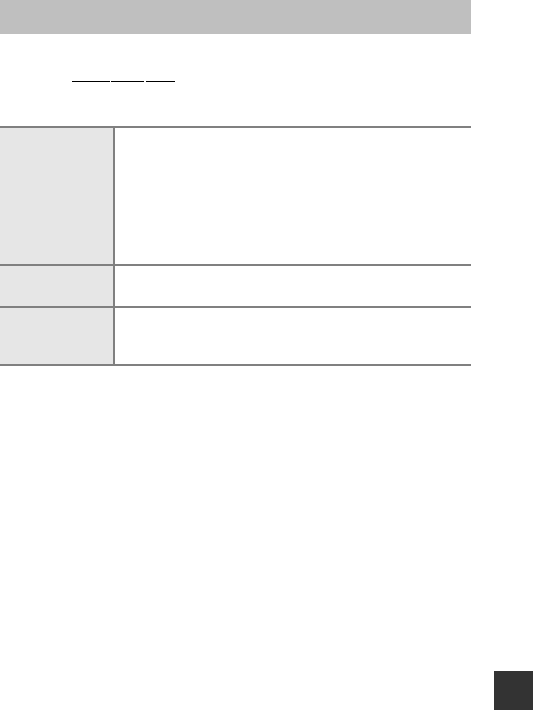
Technical Notes
147
Images or movies are assigned file names as follows.
File name: DSCN
0001
.JPG
(1) (2) (3)
File Names
(1) Identifier
Not shown on the screen of the camera.
•DSCN: Original still images, movies, still images created by
the movie editing function
•SSCN: Small picture copies
•RSCN: Cropped copies
•FSCN: Images created by an image editing function other
than crop and small picture, movies created by the movie
editing function
(2) File number Assigned in ascending order, starting with “0001” and ending
with “9999.”
(3) Extension
Indicates file format.
•.JPG: Still images
•.MOV: Movies
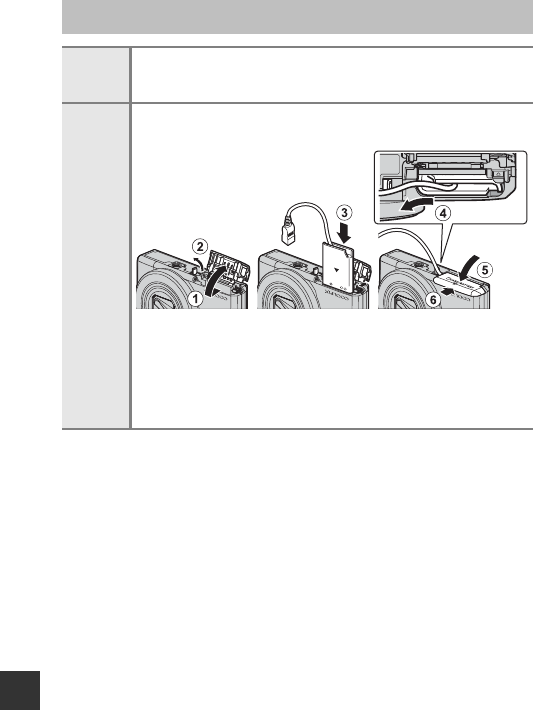
Technical Notes
148
Availability may vary with country or region.
See our website or brochures for the latest information.
Optional Accessories
Battery
Charger
Battery Charger MH-66
It takes about 1 hour and 50 minutes to charge a fully exhausted
battery.
AC
Adapter
AC Adapter EH-62G
(connect as shown)
Make sure that the power connector cable is fully inserted in the
power connector slot before inserting the AC adapter into the battery
chamber. In addition, make sure that the power connector cable is
fully inserted in the battery chamber slot before closing the battery-
chamber/memory card slot cover. If part of the cable protrudes from
the slots, the cover or cable may be damaged when the cover is
closed.

Technical Notes
149
Nikon COOLPIX S7000 Digital Camera
Specifications
Type Compact digital camera
Number of effective pixels 16.0 million (Image processing may reduce the
number of effective pixels.)
Image sensor
1/2.3-in. type CMOS; approx. 16.76 million total
pixels
Lens NIKKOR lens with 20× optical zoom
Focal length 4.5–90.0 mm (angle of view equivalent to that of
25–500 mm lens in 35mm [135] format)
f/-number f/3.4–6.5
Construction 12 elements in 10 groups (1 ED lens element)
Digital zoom magnification Up to 4× (angle of view equivalent to that of
approx. 2000 mm lens in 35mm [135] format)
Vibration reduction Lens shift (still images)
Lens shift and electronic VR (movies)
Autofocus (AF) Contrast-detect AF
Focus range
•[W]: Approx. 30 cm (1 ft)–,
[T]: Approx. 2 m (6 ft 7 in.)–
•Macro mode: Approx. 1 cm (0.4 in.)–
(wide-
angle position)
(All distances measured from center of front surface
of lens)
Focus-area selection Face priority, manual with 99 focus areas, center,
subject tracking, target finding AF
Monitor
7.5 cm (3-in.), approx. 460k-dot, TFT LCD with anti-
reflection coating and 5-level brightness
adjustment
Frame coverage
(shooting mode)
Approx. 99% horizontal and vertical (compared to
actual picture)
Frame coverage
(playback mode)
Approx. 99% horizontal and vertical (compared to
actual picture)

Technical Notes
150
Storage
Media Internal memory (approx. 20 MB),
SD/SDHC/SDXC memory card
File system DCF and Exif 2.3 compliant
File formats
Still images: JPEG
Movies: MOV (Video: H.264/MPEG-4 AVC, Audio:
LPCM stereo)
Image size
(pixels)
•16M (High) [4608×3456P]
•16M [4608×3456]
•8M [3264×2448]
•4M [2272×1704]
•2M [1600×1200]
•VGA [640×480]
•16:9 [4608×2592]
•1:1 [3456×3456]
ISO sensitivity
(Standard output
sensitivity)
•ISO 125–1600
•ISO 3200, 6400 (available when using Auto
mode)
Exposure
Metering mode Matrix, center-weighted (digital zoom less than 2×),
spot (digital zoom 2× or more)
Exposure control
Programmed auto exposure and exposure
compensation
(–2.0 – +2.0 EV in steps of 1/3 EV)
Shutter Mechanical and CMOS electronic shutter
Speed
•1/1500–1 s
•1/4000 s (maximum speed during high-speed
continuous shooting)
•4 s (Fireworks show scene mode)
Aperture Electronically-controlled ND filter (–2 AV) selection
Range 2 steps (f/3.4 and f/6.8 [W])
Self-timer Can be selected from 10 s and 2 s
Flash
Range (approx.)
(ISO sensitivity: Auto)
[W]: 0.5–2.8 m (1 ft 8 in.–9 ft 2 in.)
[T]: 2.0 m (6 ft 6 in.)
Flash control TTL auto flash with monitor preflashes

Technical Notes
151
Interface
USB connector
Micro-USB connector (Do not use any USB cable
other than the UC-E21.), Hi-Speed USB
•Supports Direct Print (PictBridge)
HDMI output connector HDMI micro connector (Type D)
Wi-Fi (Wireless LAN)
Standards IEEE 802.11b/g/n (standard wireless LAN protocol)
Range (line of sight) Approx. 10 m (10 yd)
Operating frequency 2412–2462 MHz (1–11 channels)
Data rates (actual
measured values)
IEEE 802.11b: 5 Mbps
IEEE 802.11g: 15 Mbps
IEEE 802.11n: 15 Mbps
Security OPEN/WPA2
Access protocols Infrastructure
Supported languages
Arabic, Bengali, Bulgarian, Chinese (Simplified and
Traditional), Czech, Danish, Dutch, English, Finnish,
French, German, Greek, Hindi, Hungarian,
Indonesian, Italian, Japanese, Korean, Marathi,
Norwegian, Persian, Polish, Portuguese (European
and Brazilian), Romanian, Russian, Serbian, Spanish,
Swedish, Tamil, Telugu, Thai, Turkish, Ukrainian,
Vietnamese
Power sources One Rechargeable Li-ion Battery EN-EL19 (included)
AC Adapter EH-62G (available separately)
Charging time Approx. 1 h 50 min (when using Charging AC
Adapter EH-71P and when no charge remains)
Battery life1
Still images Approx. 210 shots when using EN-EL19
Movies (actual battery
life for recording)2Approx. 40 min when using EN-EL19
Tripod socket 1/4 (ISO 1222)
Dimensions (W × H × D) Approx. 99.5 × 60.0 × 27.4 mm (4.0 × 2.4 × 1.1 in.)
(excluding projections)
Weight Approx. 161 g (5.7 oz) (including battery and
memory card)
Operating environment
Temperature 0°C–40°C (32°F–104°F)
Humidity 85% or less (no condensation)

Technical Notes
152
•Unless otherwise stated, all figures assume a fully-charged battery and an
ambient temperature of 23 ±3°C (73.4 ±5.4°F) as specified by the Camera
and Imaging Products Association (CIPA).
1Battery life may vary depending on conditions of use, such as the interval between
shots or the length of time that menus and images are displayed.
2Individual movie files cannot exceed 4 GB in size or 29 minutes in length.
Recording may end before this limit is reached if camera temperature becomes
elevated.
Rechargeable Li-ion Battery EN-EL19
Charging AC Adapter EH-71P
•Nikon will not be held liable for any errors this manual may contain.
•The appearance of this product and its specifications are subject to change
without notice.
Type Rechargeable lithium-ion battery
Rated capacity DC 3.7 V, 700 mAh
Operating temperature 0°C–40°C (32°F–104°F)
Dimensions (W × H × D) Approx. 31.5 × 39.5 × 6 mm (1.3 × 1.6 × 0.3 in.)
Weight Approx. 14.5 g (0.5 oz)
Rated input AC 100–240 V, 50/60 Hz, MAX 0.2 A
Rated output DC 5.0 V, 1.0 A
Operating temperature 0°C–40°C (32°F–104°F)
Dimensions (W × H × D)
Approx. 55 × 22 × 54 mm (2.2 × 0.9 × 2.2 in.)
(excluding plug adapter)
For Argentina: Approx. 55 × 63 × 59 mm (2.2 × 2.5 ×
2.4 in.)
Weight Approx. 48 g (1.7 oz) (excluding plug adapter)
For Argentina: Approx. 73 g (2.6 oz)
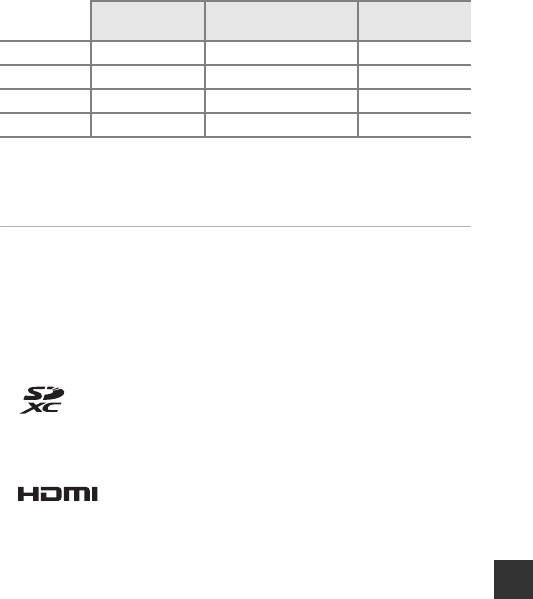
Technical Notes
153
Approved Memory Cards
The following Secure Digital (SD) memory cards have been tested and
approved for use in this camera.
•Memory cards with an SD Speed Class rating of 6 or faster are
recommended for recording movies. When using a memory card with a
lower Speed Class rating, movie recording may stop unexpectedly.
•Contact the manufacturer for details on the above cards. We cannot guarantee
camera performance when using memory cards made by other manufacturers.
•If you use a card reader, make sure that it is compatible with your memory card.
Trademark Information
•Windows is either a registered trademark or trademark of Microsoft
Corporation in the United States and/or other countries.
•Adobe, the Adobe logo, and Reader are either trademarks or registered
trademarks of Adobe Systems Incorporated in the United States and/or
other countries.
•SDXC, SDHC, and SD Logos are trademarks of SD-3C, LLC.
•PictBridge is a trademark.
•HDMI, HDMI logo and High-Definition Multimedia Interface are
trademarks or registered trademarks of HDMI Licensing LLC.
•Wi-Fi and the Wi-Fi logo are trademarks or registered trademarks of the
Wi-Fi Alliance.
•Android and Google Play are trademarks or registered trademarks of
Google, Inc.
SD memory card SDHC memory card SDXC memory
card
SanDisk 2 GB 4 GB, 8 GB, 16 GB, 32 GB 64 GB, 128 GB
TOSHIBA – 4 GB, 8 GB, 16 GB, 32 GB 64 GB
Panasonic 2 GB 4 GB, 8 GB, 16 GB, 32 GB 64 GB
Lexar – 4 GB, 8 GB, 16 GB, 32 GB 64 GB, 128 GB

Technical Notes
154
•The N-Mark is a trademark or registered trademark of NFC Forum, Inc. in
the United States and in other countries.
•All other trade names mentioned in this manual or the other
documentation provided with your Nikon product are the trademarks or
registered trademarks of their respective holders.
AVC Patent Portfolio License
This product is licensed under the AVC Patent Portfolio License for the
personal and non-commercial use of a consumer to (i) encode video in
compliance with the AVC standard (“AVC video”) and/or (ii) decode AVC
video that was encoded by a consumer engaged in a personal and non-
commercial activity and/or was obtained from a video provider licensed to
provide AVC video. No license is granted or shall be implied for any other
use. Additional information may be obtained from MPEG LA, L.L.C.
See http://www.mpegla.com.
FreeType License (FreeType2)
•Portions of this software are copyright © 2012 The FreeType Project
(http://www.freetype.org). All rights reserved.
MIT License (HarfBuzz)
•Portions of this software are copyright © 2015 The HarfBuzz Project
(http://www.freedesktop.org/wiki/Software/HarfBuzz). All rights
reserved.

155
Technical Notes
Symbols
A Auto mode...................... 12, 19, 21
x Scene auto selector mode
................................................................ 22, 23
W Backlighting mode.............. 22, 24
y Scene mode......................... 22
n Short movie show mode ......... 38
u Special effects mode..... 33
F Smart portrait mode.................. 35
X Night landscape mode .... 22, 24
c Playback mode.............................. 16
C List by date mode........................ 60
g (Telephoto)......................................... 15
f (Wide-angle).................................... 15
i Playback zoom ................................. 58
h Thumbnail playback.................. 59
j Help....................................................... 23
m Flash mode ......................................... 41
n Self-timer........................................... 43
p Macro mode.................................... 45
o Exposure compensation ......... 49
Z Wi-Fi button ...... 2, 117, 118, 120
c Playback button ...................... 2, 16
b (e movie-record) button
.......................................................... 2, 20, 69
k Apply selection button ................ 2
d Menu button
...................................... 2, 33, 68, 76, 126
l Delete button..................... 2, 17, 62
Y N-Mark .............................. 2, 118, 120
A
AC adapter ................................. 121, 148
AF area mode ......................................... 85
AF assist............................................... 1, 111
Aperture value ....................................... 15
Auto flash................................................. 42
Auto mode ............................... 12, 19, 21
Auto off............................................ 14, 113
Auto with red-eye reduction ....... 42
Autofocus..................... 54, 71, 88, 101
Autofocus mode....................... 88, 101
B
Backlighting mode .................... 22, 24
Battery ................................... 7, 8, 11, 152
Battery chamber........................... 7, 148
Battery-chamber/memory card slot
cover.......................................................... 2, 7
Battery charger.............................. 9, 148
Battery latch................................................ 7
Beach Z................................................... 22
Blink proof................................................ 90
Brightness..................................... 47, 108
Button sound ....................................... 112
C
Calendar Display .................................. 59
Capturing still images while
recording movies ................................ 72
Center......................................................... 86
Charge by computer....................... 115
Charge lamp......................................... 2, 8
Charger .............................................. 9, 148
Charging AC Adapter..... 8, 133, 152
Close-up k.................................... 22, 26
Cloudy ........................................................ 80
Compression ratio............................... 78
Computer................................... 122, 128
Conformity marking ........................ 116
Connecting to smart devices
.......................................................... 104, 118
Connector cover ................................. 1, 8
Continuous.............................................. 82
Index

156
Technical Notes
Copying images................................... 94
Creative slider........................................ 46
Crop..................................................... 58, 68
Cross process o.................................. 33
Current settings ................................. 104
D
Date and time ............................. 10, 106
Date format................................... 10, 106
Date stamp............................................. 110
Daylight..................................................... 80
Daylight saving time ....... 10, 11, 106
Delete................................................. 17, 62
Digital zoom.................................. 15, 112
Direct print ................................ 122, 124
D-Lighting ............................................... 64
Dusk/dawn i....................................... 22
E
Easy panorama p...................... 22, 30
Easy panorama playback................. 32
Editing images....................................... 63
EH-71P...................................................... 152
EN-EL19 ................................................... 152
Exposure compensation........ 47, 49
Eyelet for camera strap................... ii, 1
F
Face detection....................................... 53
Face priority............................................. 85
File names.............................................. 147
Fill flash...................................................... 42
Fireworks show m..................... 22, 26
Firmware version................................ 116
Fixed range auto.................................. 84
Flash ............................................... 1, 41, 80
Flash lamp .......................................... 2, 41
Flash mode ..................................... 41, 42
Flash off..................................................... 42
Fluorescent ............................................. 80
Focus................................................... 52, 85
Focus area................................................ 52
Focus indicator ................................. 3, 13
Focus lock ................................................. 55
Food u.............................................. 22, 26
Format internal memory............... 114
Format memory cards.............. 7, 114
Formatting....................................... 7, 114
Frame rate.............................................. 103
Full-frame playback............................ 58
Full-time AF.................................. 88, 101
Functions that cannot be used
simultaneously...................................... 56
G
Glamour retouch ........................ 35, 66
H
HDMI cable................................ 122, 123
HDMI micro connector............. 1, 121
HDR .............................................................. 24
Help.............................................................. 23
High-contrast mono. F.................. 33
High-speed continuous .................. 82
Histogram................................................. 47
HS movie....................................... 98, 100
Hue............................................................... 48
I
Image mode........................................... 78
Image quality ......................................... 78
Image review....................................... 108
Image selection .................................... 96
Image size ................................................ 78
Incandescent.......................................... 80
Internal memory ...................................... 7
Internal memory indicator
.............................................................. 3, 5, 12
Interval ....................................................... 89
ISO sensitivity......................................... 84

157
Technical Notes
L
Landscape c......................................... 22
Language ............................................... 114
Lens............................................ 1, 135, 149
Lens cover..................................................... 1
List by date mode............................... 60
M
Macro mode........................................... 45
Mark for Wi-Fi upload ............. 91, 120
Memory card............................. 134, 153
Memory card slot .................................... 7
Microphone (stereo) .............................. 1
Micro-USB connector ........... 1, 8, 121
Mirror b................................................... 34
Mode dial ..................................... 1, 12, 19
Monitor......................................... 2, 3, 135
Monitor settings ................................ 108
Movie editing ................................ 73, 74
Movie menu................................... 76, 97
Movie options ........................................ 97
Movie recording .......................... 20, 69
Movie VR................................................. 102
Multi selector................... 2, 16, 20, 76
N
NFC ............................................ 2, 118, 120
Night landscape mode............ 22, 24
Night portrait e.......................... 22, 25
Nikon Transfer 2 ................................. 129
N-Mark...................................... 2, 118, 120
Nostalgic sepia P...................... 33
Number of exposures remaining
......................................................................... 79
Number of shots.................................. 89
O
Optical zoom .......................................... 15
Optional accessories ....................... 148
Options.................................................... 104
P
Paper size.................................... 125, 126
Party/indoor f............................ 22, 25
Pet portrait auto release.................. 27
Pet portrait O............................... 22, 27
Photo info.............................................. 108
Photo VR................................................... 111
PictBridge ................................... 122, 124
Playback ..................................................... 16
Playback menu.............................. 76, 91
Playback mode....................................... 16
Playback zoom.............................. 16, 58
Pop l...................................................... 33
Portrait b................................................. 22
Power connector cover........... 2, 148
Power switch/power-on lamp
.................................................................... 1, 10
Pre-focus................................................... 88
Preset manual......................................... 81
Pre-shooting cache................... 82, 83
Pressing all the way............................. 15
Pressing halfway ................................... 15
Print..................................... 122, 125, 126
Printer ........................................... 122, 124
Protect........................................................ 93
Q
Quick effects................................... 16, 63
Quick retouch........................................ 64
R
Rechargeable Li-ion battery ....... 152
Recording slow motion movies
............................................................ 98, 100
Red-eye correction ............................. 65
Remaining movie recording time
............................................................... 69, 70
Reset all.................................................... 116
Restore default settings................ 104
Rotate image.......................................... 93

158
Technical Notes
S
Scene auto selector mode .... 22, 23
Scene mode ............................................ 22
SD memory card..................... 134, 153
Security settings...................... 104, 119
Selective color I................................ 33
Self-Collage..................................... 37, 89
Self-timer.................................................. 43
Self-timer lamp................................ 1, 44
Sequence display options ..... 61, 95
Setup menu................................. 76, 106
Shooting.................................................... 19
Shooting menu ................... 76, 78, 80
Shooting mode..................................... 19
Short movie show mode................. 38
Shutter sound.............................. 89, 112
Shutter speed......................................... 15
Shutter-release button ......... 1, 13, 15
Single........................................................... 82
Single AF......................................... 88, 101
Skin softening............................... 54, 66
Slide show ................................................ 92
Slow sync ................................................. 42
Small picture ........................................... 67
Smart portrait menu.................. 76, 89
Smart portrait mode .......................... 35
Smile timer............................................... 36
Snow z..................................................... 22
Soft O................................................ 33
Sound settings..................................... 112
Speaker........................................................... 1
Special effects mode.......................... 33
Sports d........................................... 22, 25
Strap ........................................................... ii, 1
Subject tracking........................... 86, 87
Sunset h.................................................. 22
T
Target finding AF......................... 52, 86
Telephoto.................................................. 15
Televisions.................................. 122, 123
Text input ............................................... 105
Thumbnail display ...................... 16, 59
Time difference.................................. 106
Time-lapse movie N............... 22, 28
Time zone....................................... 11, 106
Time zone and date................ 10, 106
Toy camera effect 1 m.................... 33
Toy camera effect 2 n................... 34
Tripod socket................................... 2, 151
U
Upload from camera ........... 104, 120
USB cable................... 8, 122, 124, 128
V
ViewNX 2..................................... 122, 128
Vividness ................................................... 48
Volume....................................................... 73
W
White balance........................................ 80
Wide-angle ............................................... 15
Wi-Fi button.......................... 2, 117, 118
Wi-Fi disconnection............. 104, 119
Wi-Fi options menu ..... 76, 104, 119
Wind noise reduction ..................... 103
Wireless LAN......................................... 117
Z
Zoom control..................................... 1, 15
Zooming in/out..................................... 15

6MN52611-01
FX4L01(11)
No reproduction in any form of this manual, in whole or in part
(except for brief quotation in critical articles or reviews), may be
made without written authorization from NIKON CORPORATION.
© 2015 Nikon Corporation